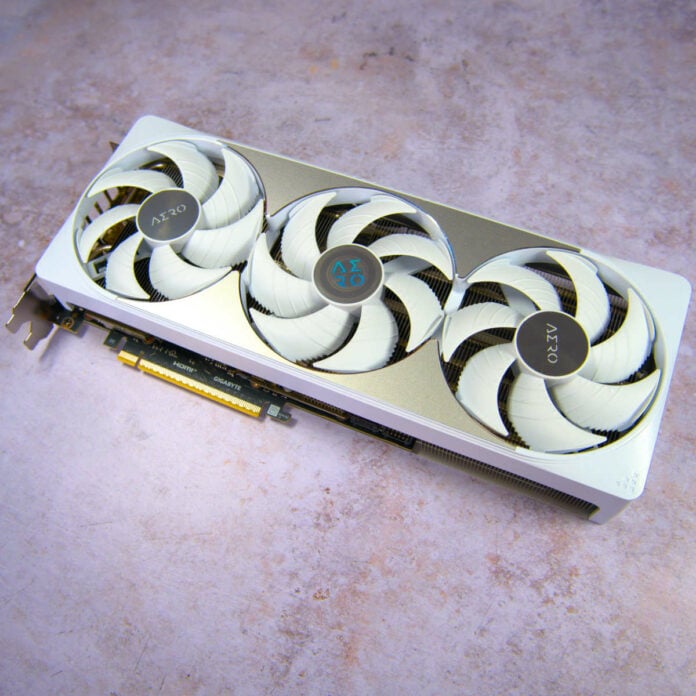On paper GeForce RTX 5080 is a great graphics card and the likes of Gigabyte’s Aero OC SFF are among the prettiest. These qualities are true in practice but the best partner cards risk venturing into no man’s land when it comes to pricing. With Nvidia’s Founders Edition sat pretty at $999, it’s impossible to ignore how much Gigabyte’s $1,399 price tag dulls Aero OC’s shine.
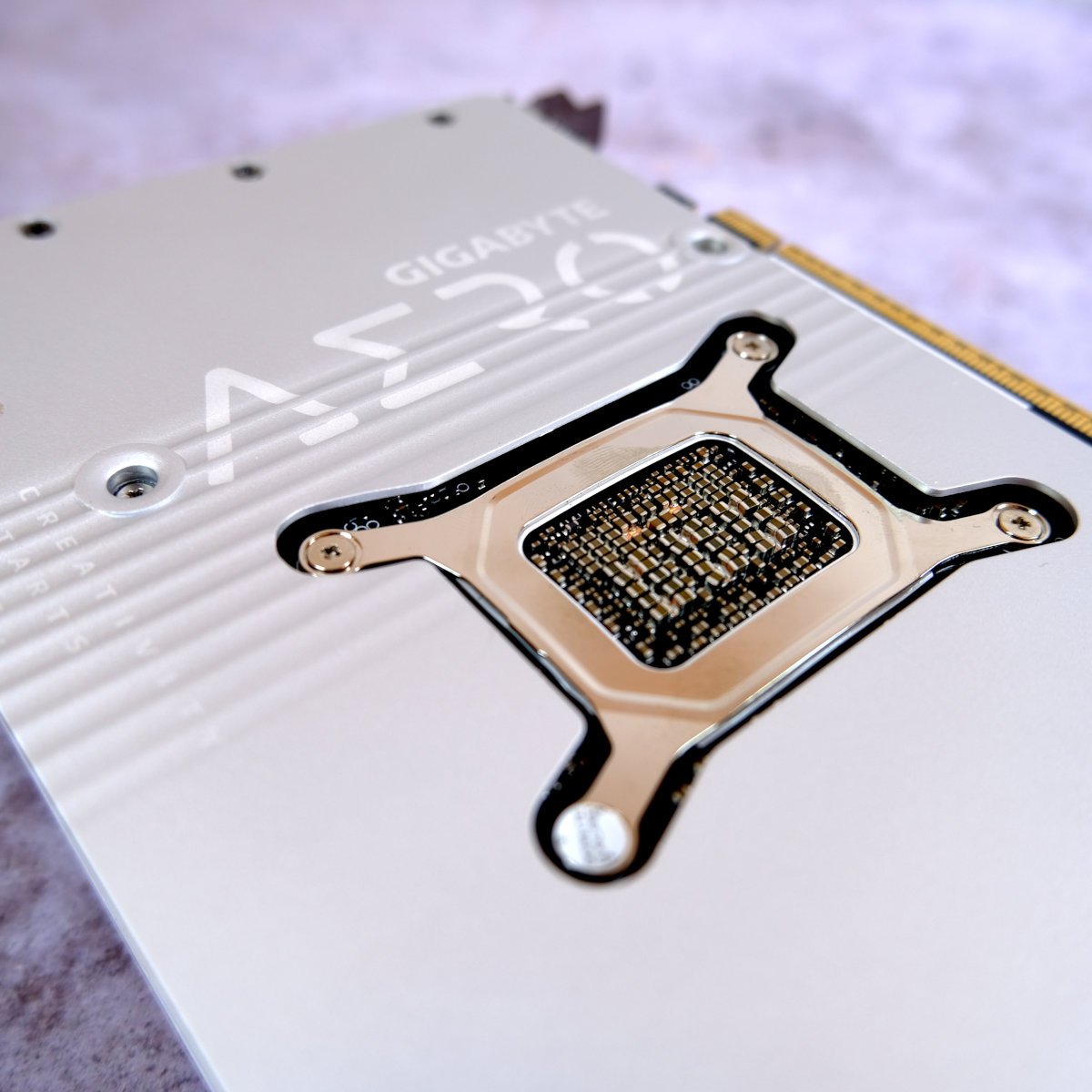

Gigabyte GeForce RTX 5080 Aero OC SFF
£1,419 / $1,399
Pros
- Silky 4K UHD gameplay
- Faster than Founders Edition
- Two-slot SFF cooler
- Cool under load
- High-quality, stylish build
Cons
- Huge premium versus MSRP
- Performance BIOS gets noisy
Club386 may earn an affiliate commission when you purchase products through links on our site.
How we test and review products.
Such a premium puts it a staggering $400 above Nvidia’s target price. Here in the UK Gigabyte’s card is actually available to order at £1,319 – yes, below MSRP – but the discussion serves to highlight how RTX 5080 costs can escalate if you fancy the flashiest models. There are cards fetching over £1,500 at retail, and while there’s plenty to love about Gigabyte’s SFF design, there’s a reason why folk are clamouring to get their hands on the £979 Founders Edition.
Specifications
Gigabyte fits Aero OC SFF with a 113MHz overclock, bringing boost frequencies up to 2,730MHz out of the box. Of course, if operating temperatures are low enough then GPU Boost will push clock speeds just above 2,800MHz in my experience.
Outside of this overclock, though, the core specifications of Aero OC SFF are the same as every other GeForce RTX 5080. Before we dive into the specifics, here’s the Club386 Table of Doom™ for at-a-glance comparison between Nvidia’s new GPU and its predecessor.
| GeForce RTX | 5080 | 4080 Super | 3080 |
|---|---|---|---|
| Launch date | Jan 2025 | Jan 2024 | Sep 2020 |
| Codename | GB203 | AD103 | GA102 |
| Architecture | Blackwell | Ada Lovelace | Ampere |
| Process | TSMC 4N (4nm) | TSMC 4N (4nm) | Samsung 8N |
| Transistors (bn) | 45.6 | 45.9 | 28.3 |
| Die size (mm2) | 378 | 378.6 | 628.4 |
| SMs | 84 of 84 | 80 of 80 | 68 of 84 |
| CUDA cores | 10,752 | 10,240 | 8,704 |
| Boost clock (MHz) | 2,617 | 2,550 | 1,710 |
| Peak FP32 TFLOPS | 56.3 | 52.2 | 29.77 |
| RT cores | 84 (4th Gen) | 80 (3rd Gen) | 68 (2nd Gen) |
| RT TFLOPS | 170.6 | 121 | 58 |
| Tensor cores | 336 (5th Gen) | 320 (4th Gen) | 272 (3rd Gen) |
| FP16 Acc TFLOPS | 450.2 | 418 | 238.2 |
| Peak FP4 TFLOPS | 1,801 | 836 | – |
| ROPs | 112 | 112 | 96 |
| Texture units | 336 | 320 | 272 |
| Memory size (GB) | 16 | 16 | 10 |
| Memory type | GDDR7 | GDDR6X | GDDR6X |
| Memory bus (bits) | 256 | 256 | 320 |
| Memory clock (Gb/s) | 30 | 23 | 19 |
| Bandwidth (GB/s) | 960 | 737 | 760 |
| L2 cache (KB) | 65,536 | 65,536 | 5,120 |
| PCIe interface | Gen 5 | Gen 4 | Gen 4 |
| Video engines | 2 x NVENC (9th Gen) 2 x NVDEC (6th Gen) | 2 x NVENC (8th Gen) 1 x NVDEC (5th Gen) | 1 x NVENC (7th Gen) 1 x NVDEC (5th Gen) |
| Power (watts) | 360W | 320W | 320W |
| MSRP | $999 | $999 | $699 |
Nvidia equips the card with its GB203 chip that also features in RTX 5070 Ti, which is almost half the size (387mm2 vs. 750mm2) of the flagship GB202 found in RTX 5090. As such, the step down to second-rung is more significant than in generations past.
Regardless of this difference in approach, Nvidia still works some welcome generational uplifts into GeForce RTX 5080. CUDA, RT, and Tensor cores are all bumped in quantity and the latter two are also a cut above their predecessors in quality. Together, they bring boosts to raster, ray tracing, and AI performance over RTX 4080 Super.
GeForce RTX 5080 also boasts significantly higher memory bandwidth. This is thanks to faster GDDR7 memory chips running at 30Gb/s, so while buffer size and bus width remain the same gen-on-gen at 16GB and 256-bit, respectively, total bandwidth balloons to 960GB/s, up from the 737GB/s of its forebear.
For the sake of brevity I’ll leave technical analysis of specifications here. If you hunger for a more in-depth look at Nvidia’s GPU design and all its architectural niceties, though, give Damien’s GeForce RTX 5080 Founders Edition review a read.
Design
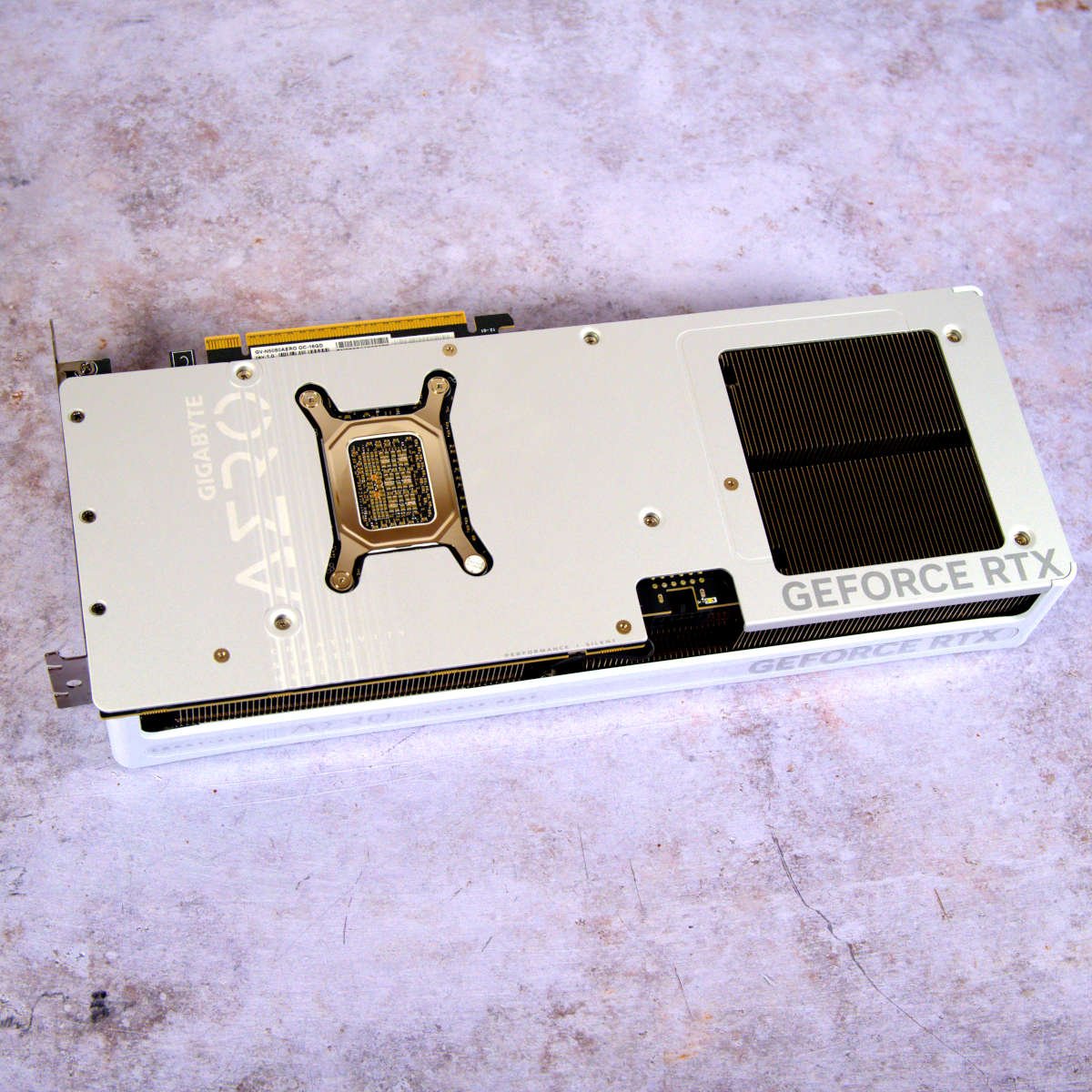
Shifting to GeForce RTX 50 Series, Gigabyte has made several changes to the design of its Aero series. In the case of Aero OC SFF, its most notable quality is a smaller cooler but there are several subtle aesthetic differences to appreciate for this generation of graphics card, too.
Measuring in at 304mm (L) x 126 (W) x 50mm (H), Aero OC adheres to Nvidia’s SFF-Ready specifications almost exactly, sparing only 25mm for its width. It’s not quite as petite as Team Green’s Founders Edition but it’s still starkly small relative to many of its chunky competitors.
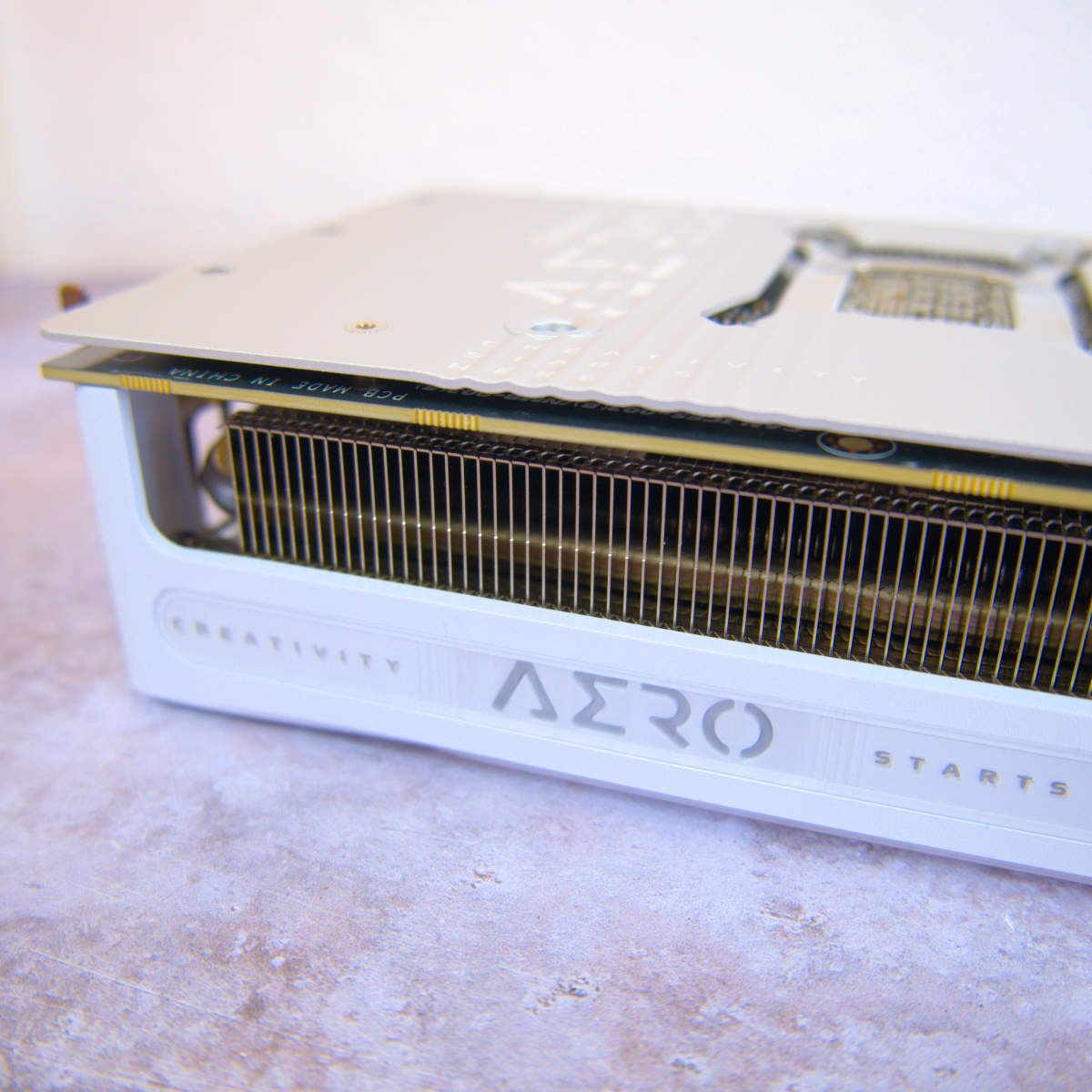
I’m fond of white graphics cards, particularly when their splashes of silver metals colour-match well to their snowy plastics. Gigabyte’s minimalist approach is classy and confident and the brand even entertains a small dash of RGB for the Aero logo. However, additional LEDs behind the ‘GeForce RTX’ logo wouldn’t go amiss.
Housed in Aero OC SFF’s dual-slot cooler, you’ll find three of Gigabyte’s ‘Hawk’ fans. The brand says it designed these blowers’ blades after taking inspiration from the aerodynamic qualities of an eagle’s wing. Aside from making for a quaint bit of trivia, this approach apparently boosts cooling by up to 12.5% without negatively impacting noise levels. They certainly look the part with interesting ridges and eye-catching reflective centres, with the middle fan adopting a flash holographic logo to boot.

Under the hood, Gigabyte outfits Aero OC SFF with a vapour chamber and composite copper heat pipes to keep the GB203 GPU nice and cool. The company opts for thermal paste in place of pads to handle VRAM and MOSFET cooling duties which should hold up well under stress but will make any attempts to disassemble and reassemble more difficult.
Aero OC SFF features a Dual BIOS switch, tucked stealthily and snugly under the backplate but protruding from a small cut-out in the PCB. Out of the box, the card is relatively unruly using its ‘Performance’ mode and I much prefer its ‘Quiet’ profile. Switching to the latter sees the card operate at 41.3db under load with temperatures averaging at 64°C.
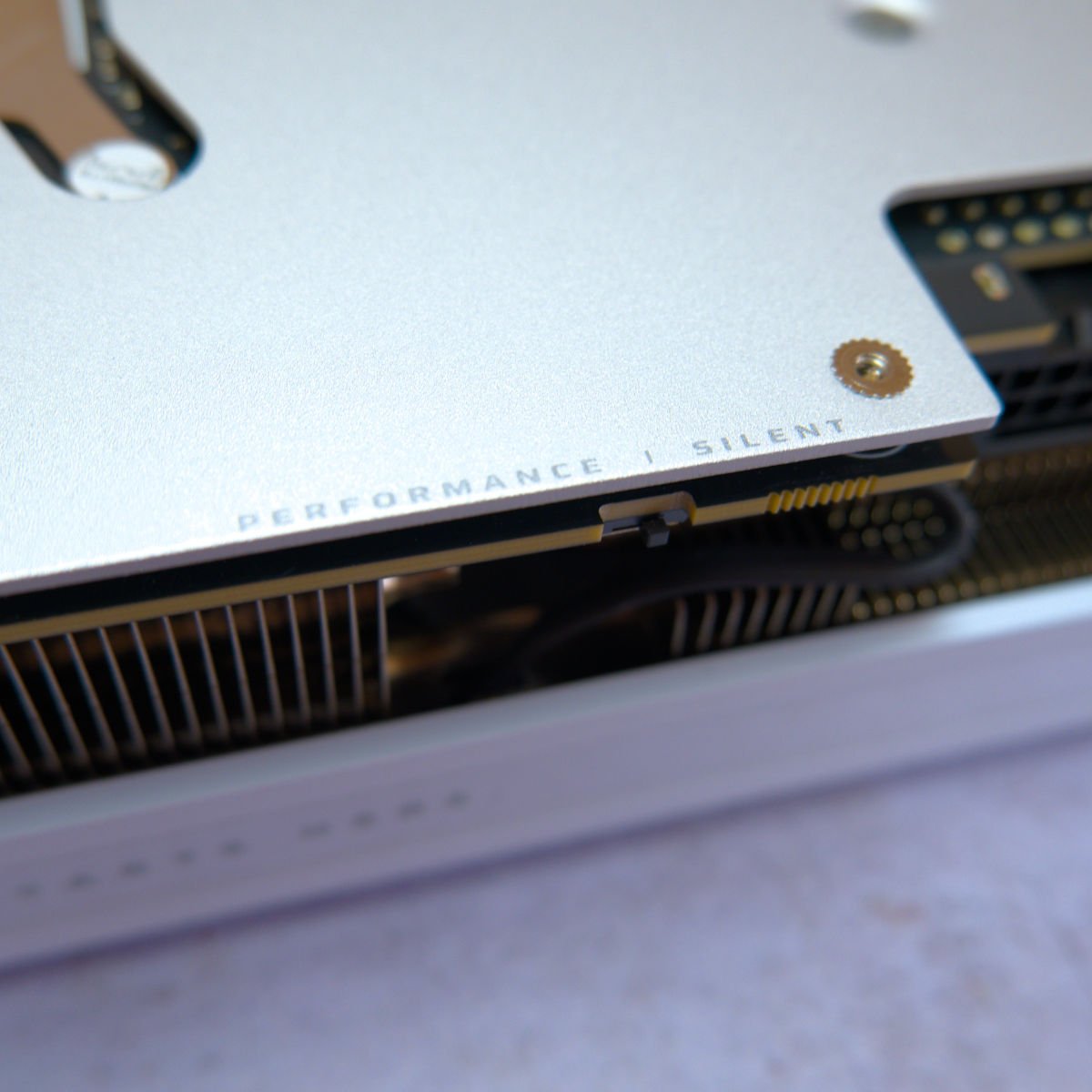
Light to the eye and touch, Aero OC SFF weighs in at an agreeable 1,277g. While not quite a featherweight pixel pusher, it is considerably less heavy than many other competitors. Gigabyte includes a GPU bracket with its GeForce RTX 5080 but it definitely feels more optional than necessary.
Rounding off the card’s included accessories is a 12V-2×6 dongle. You’ll need three 8-pin PCIe cables to sate it which feels like an unsightly pairing given the minimal, clean aesthetics of the card, but it’s useful in a pinch.
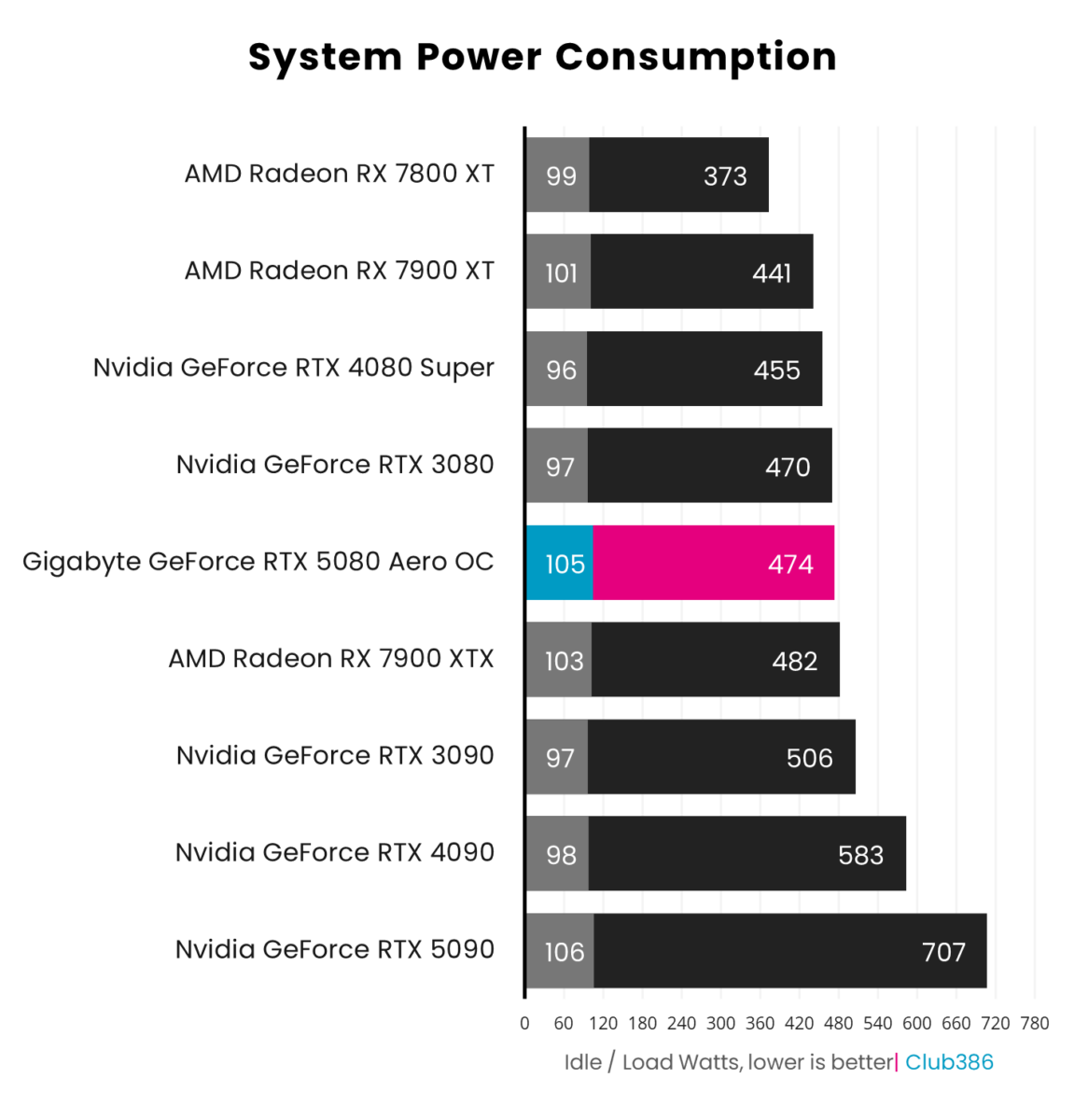
Aero OC SFF’s power consumption is around the same level as Nvidia’s Founders Edition, sitting idle at 105W and topping out at 474W. Considering the slight overclock, these are entirely reasonable numbers.
Performance
Aero OC SFF joins several other GeForce RTX 5080 cards in showing what its made of via the Club386 7950X3D test benches. These systems have more than enough mettle to keep pace with the pixel pusher, ensuring minimal GPU bottlenecks if not eliminating them entirely.
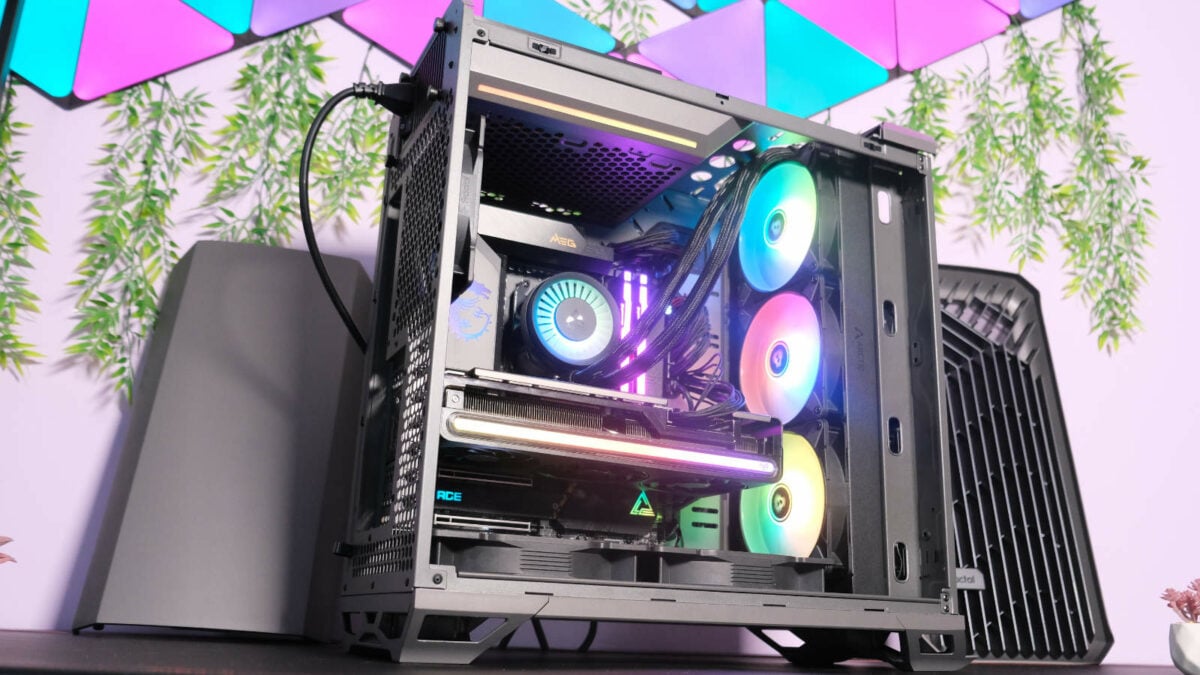
Our 7950X3D Test PCs
Club386 carefully chooses each component in a test bench to best suit the review at hand. When you view our benchmarks, you’re not just getting an opinion, but the results of rigorous testing carried out using hardware we trust.
Shop Club386 test platform components:
CPU: AMD Ryzen 9 7950X3D
Motherboard: MSI MEG X670E ACE
Cooler: Arctic Liquid Freezer III 420 A-RGB
Memory: 64GB Kingston Fury Beast DDR5
Storage: 2TB WD_Black SN850X NVMe SSD
PSU: be quiet! Dark Power Pro 13 1,300W
Chassis: Fractal Design Torrent Grey
Apps & AI
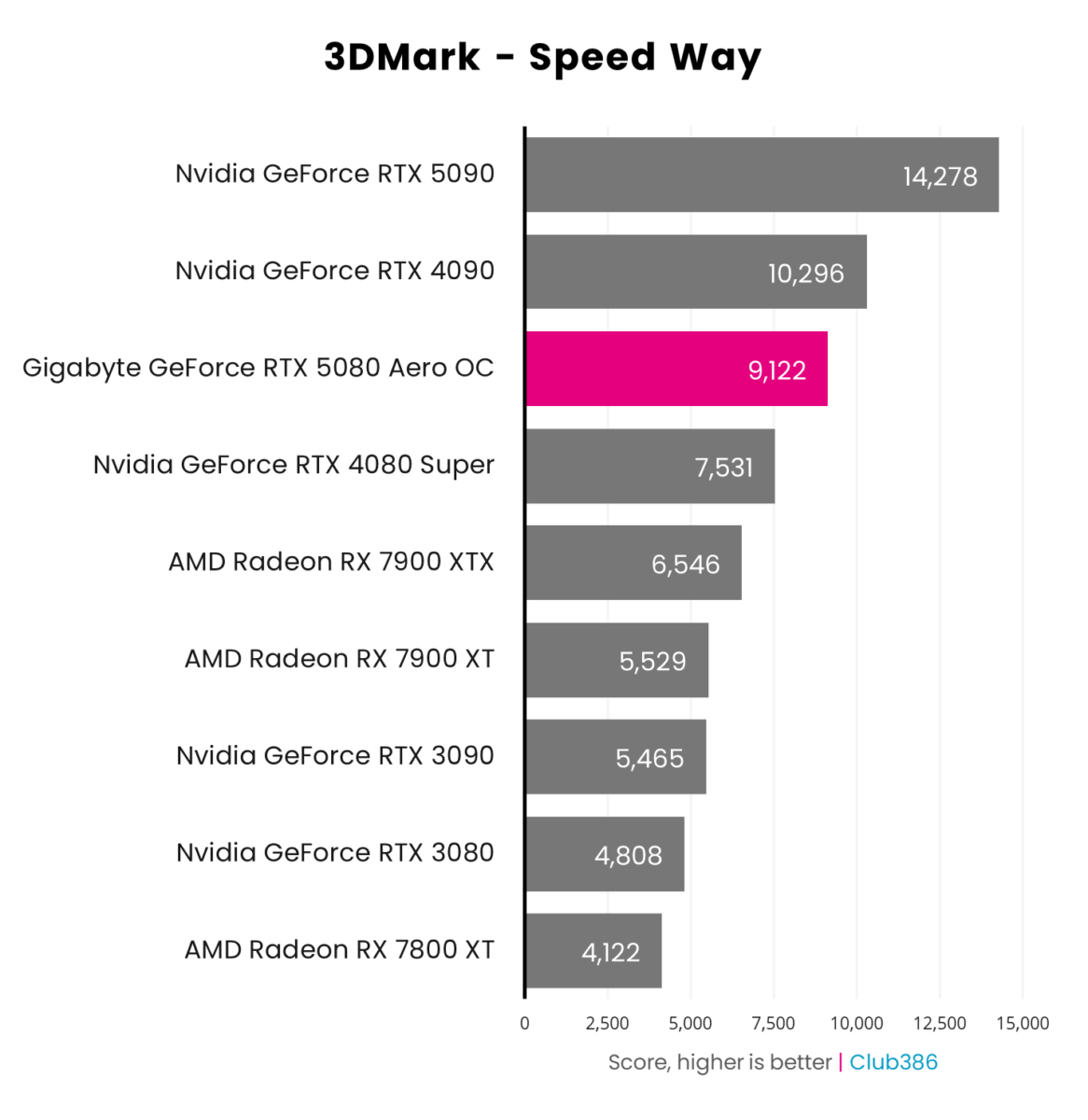
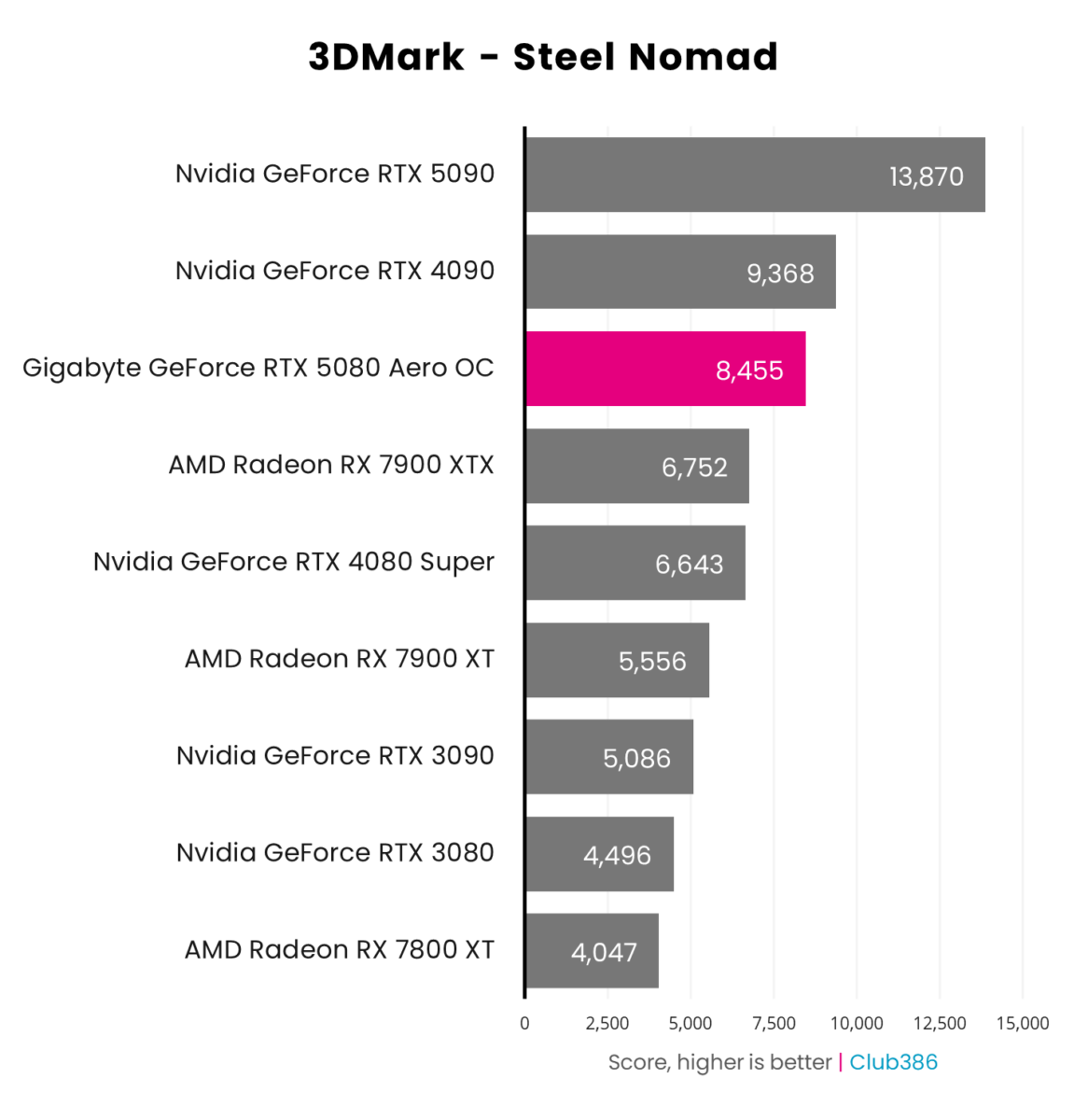
Aero OC SFF narrows the gap between GeForce RTX 5080 and 4090 thanks to its out of the box overclock, turning in scores of 9,122 and 8,455 in 3DMark Speed Way and Steel Nomad, respectively. This puts it ahead of Nvidia’s Founders Edition by over 100 points in each category.
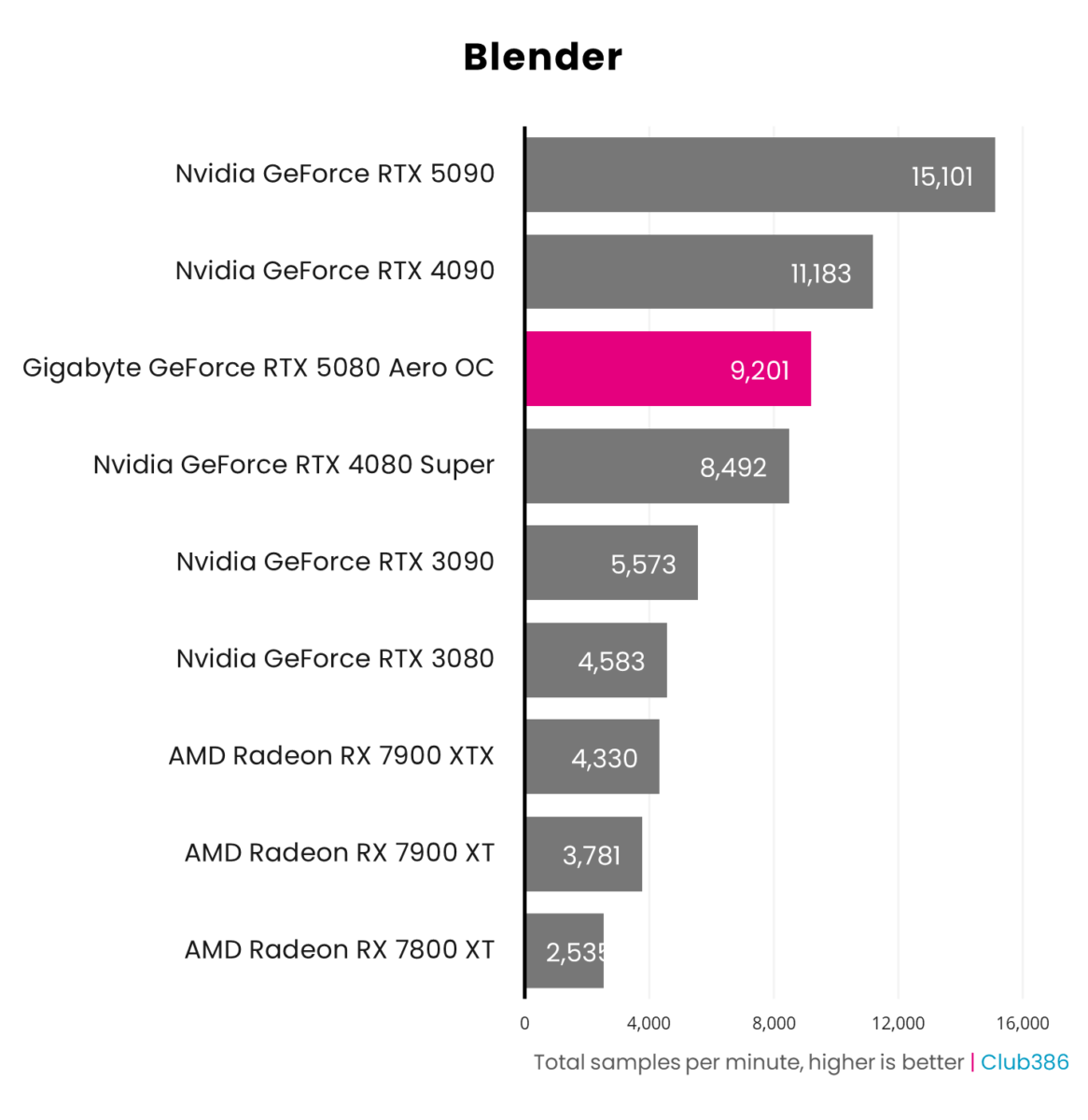
Clock speeds have little effect in Blender, but Aero OC SFF merrily performs expectedly for a GeForce RTX 5080. Turning in 9,201 samples per minute, it’s 8% ahead of its predecessor. It’s important to note that the card also boasts a generational advantage of a new generation of encoder and decoder.
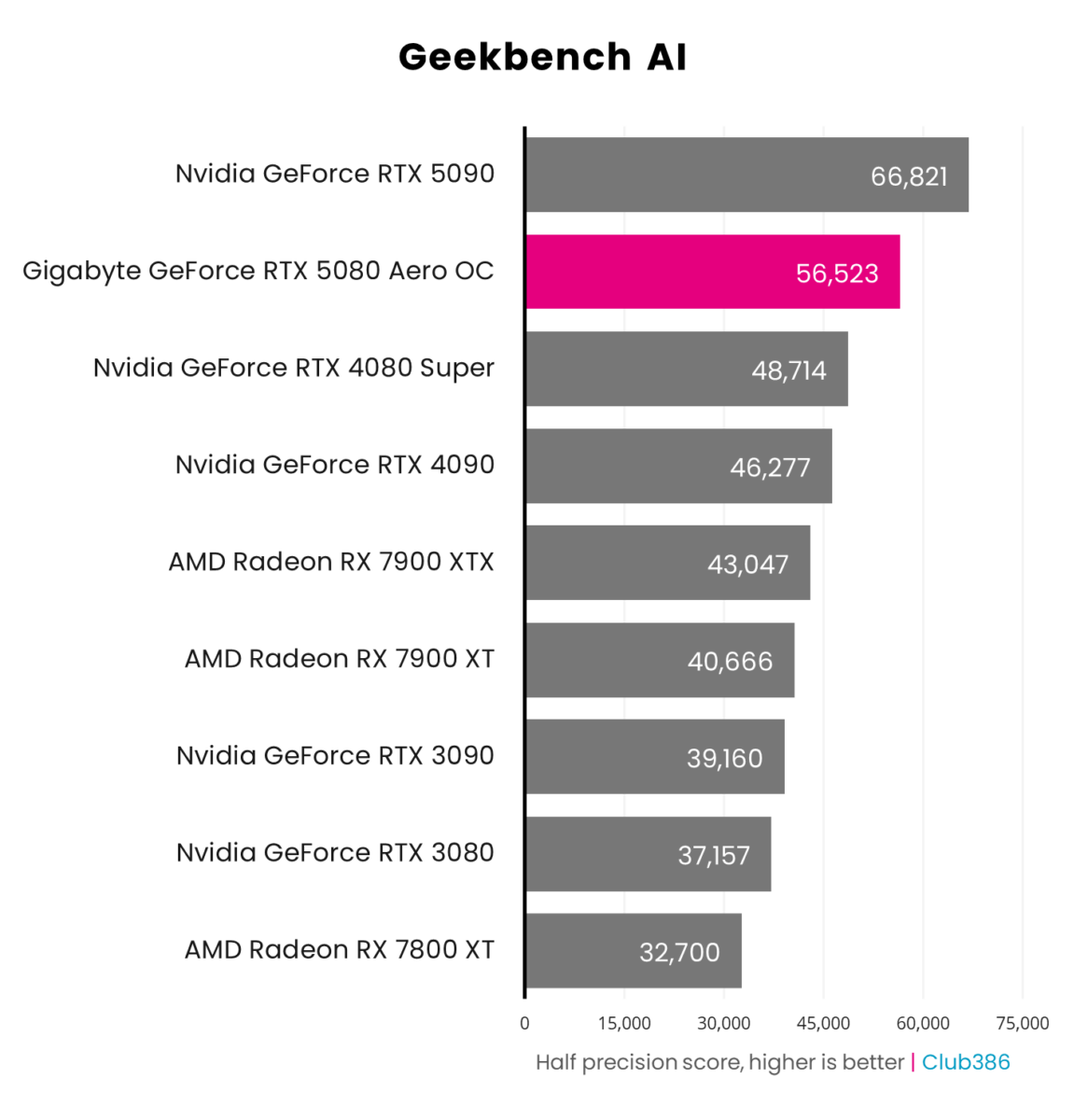
Blackwell is bestwell when it comes to AI, as GeForce RTX 5080 Aero OC SFF leapfrogs over both RTX 4090 and 4080 Super in FP16 performance. This isn’t a small bump either, as half precision scores rise by 16% over the latter card in Geekbench AI.
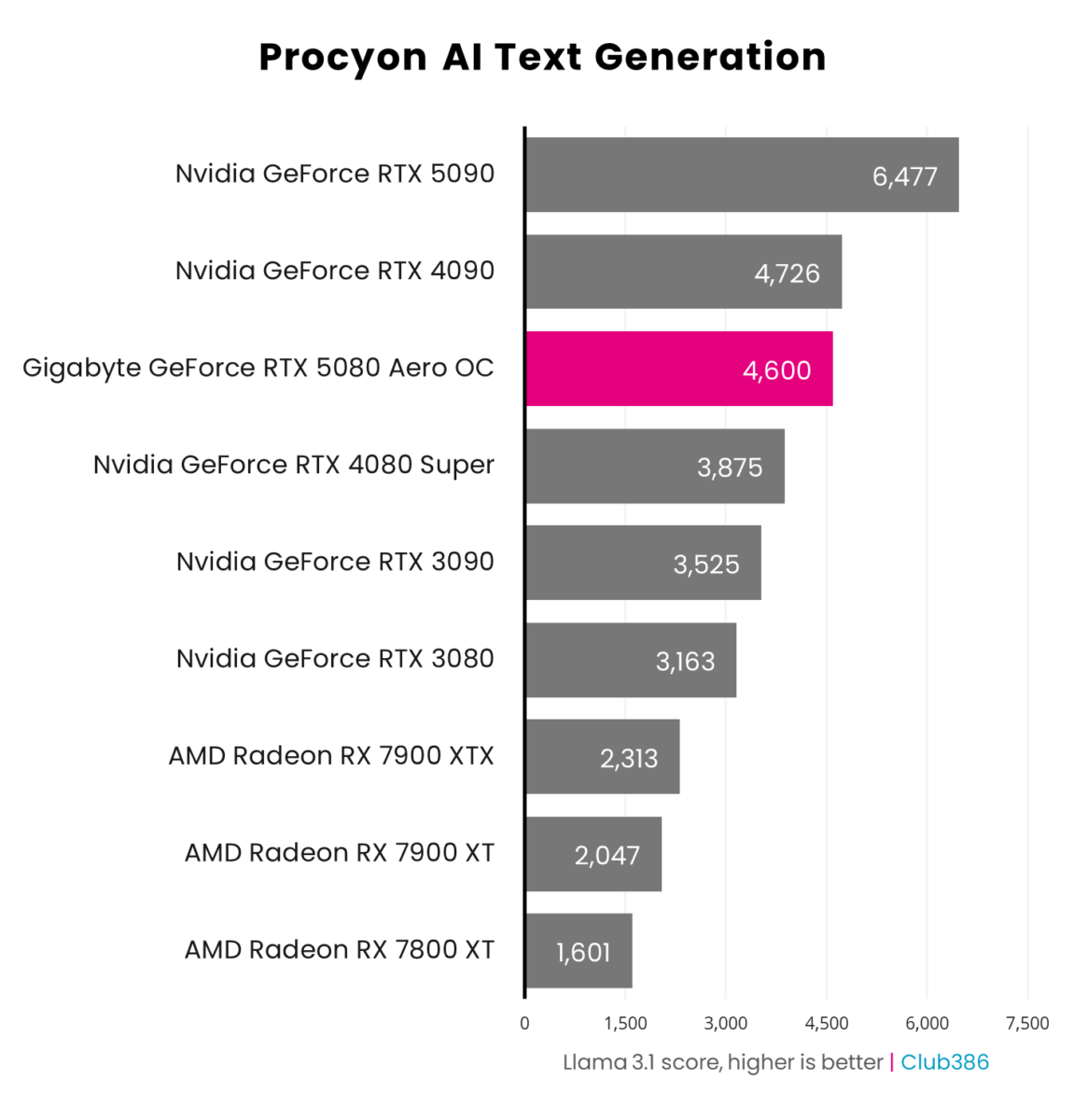
VRAM capacity counts for a lot in the world of LLMs (Large Language Models). GeForce RTX 5080’s 16GB buffer is plenty in this case, but it can’t compete with the 24GB offered by RTX 4090 despite its faster 30Gb/s modules. However, with a little over 100 points separating the two cards, it’s only just a win for the Lovelace flagship over the neophyte Blackwell GPU.
Gaming
GeForce RTX 5080 is a capable card for all major resolutions. As such, I’ve benchmarked Aero OC SFF at FHD (1080p), QHD (1440p), and UHD (2160p) across the test suite.
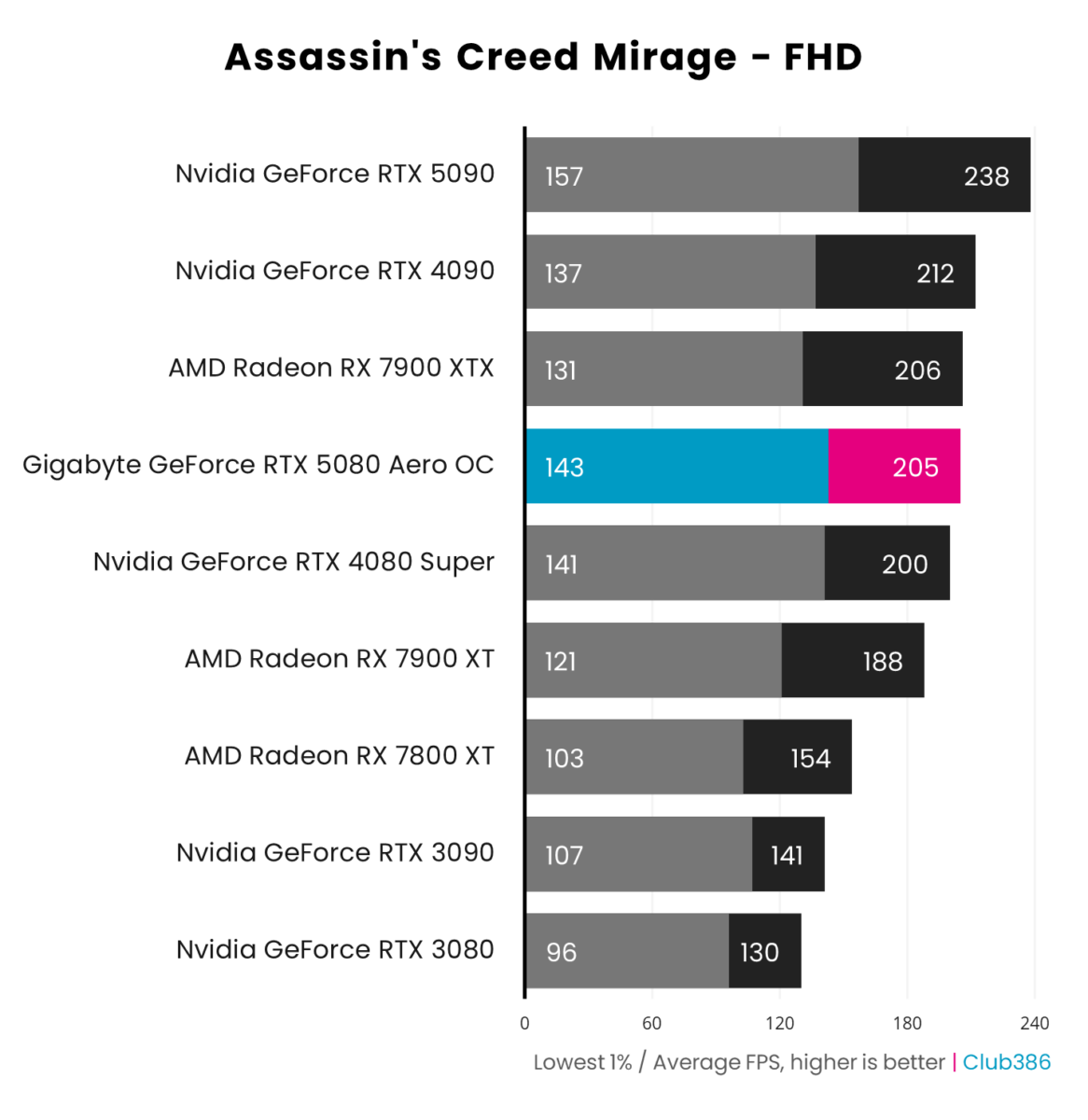
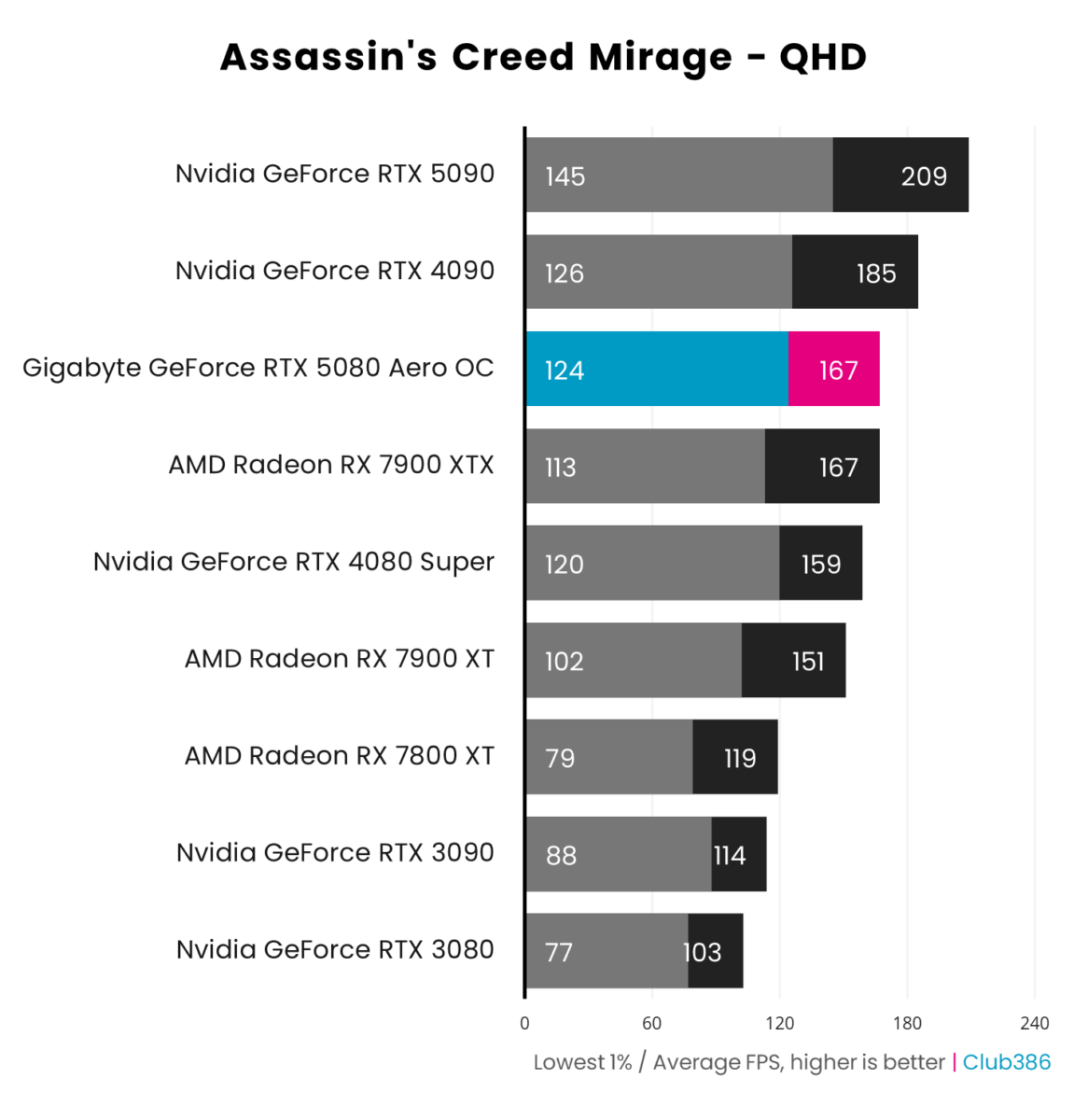
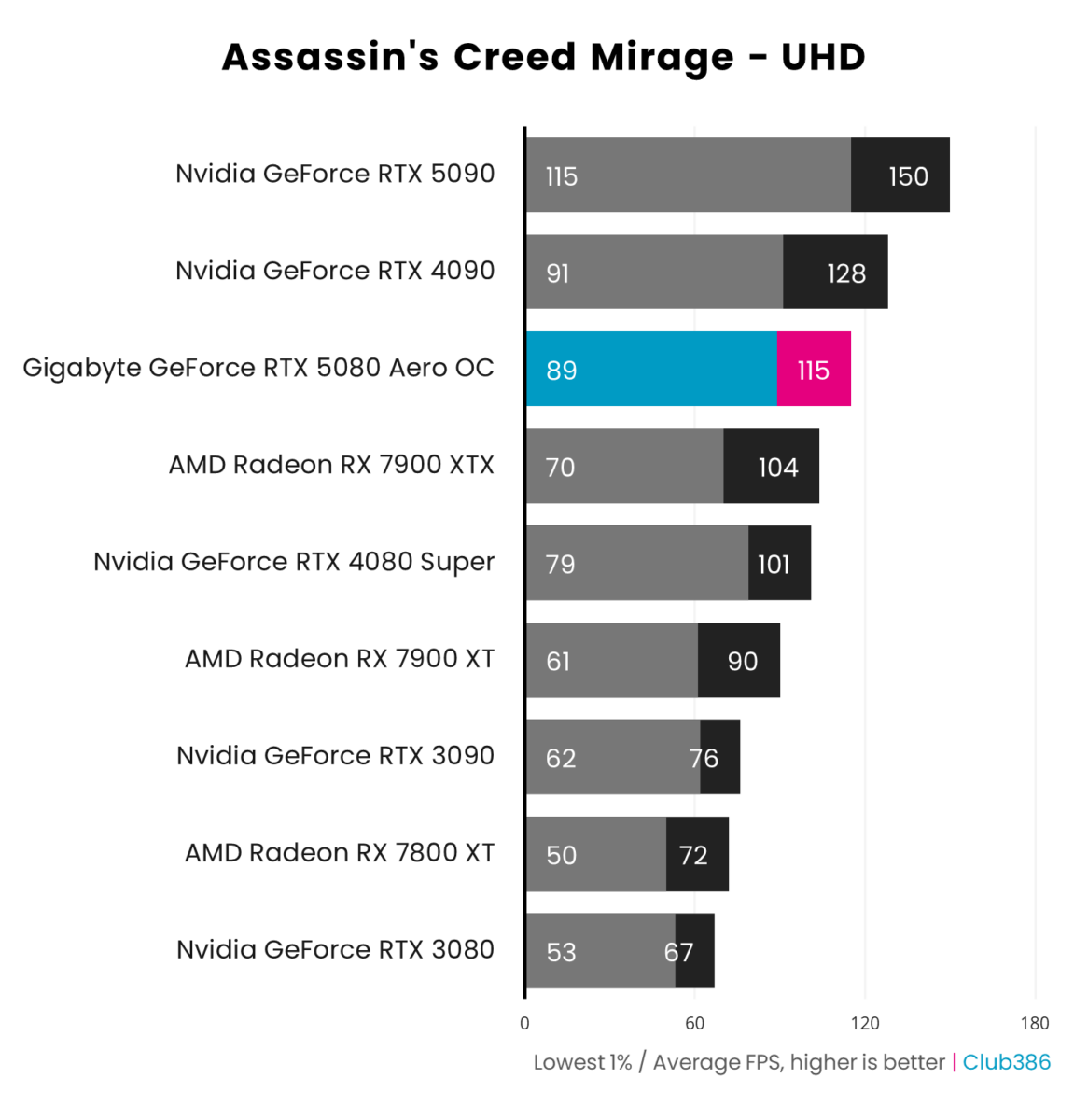
Aero OC SFF loses out to Radeon RX 7900 XTX by a whisker running Assassin’s Creed Mirage at FHD. However, it reclaims its place as bronze medallist at QHD and UHD, thanks to its more consistent 1% lows and greater average frame rate.
Rasterised rendering isn’t the primary focus of Nvidia’s Blackwell architecture, as is clear by the frame rates above. Nevertheless, this GeForce RTX 5080 does deliver better value as resolutions increase, offering a 14% generational bump at UHD.
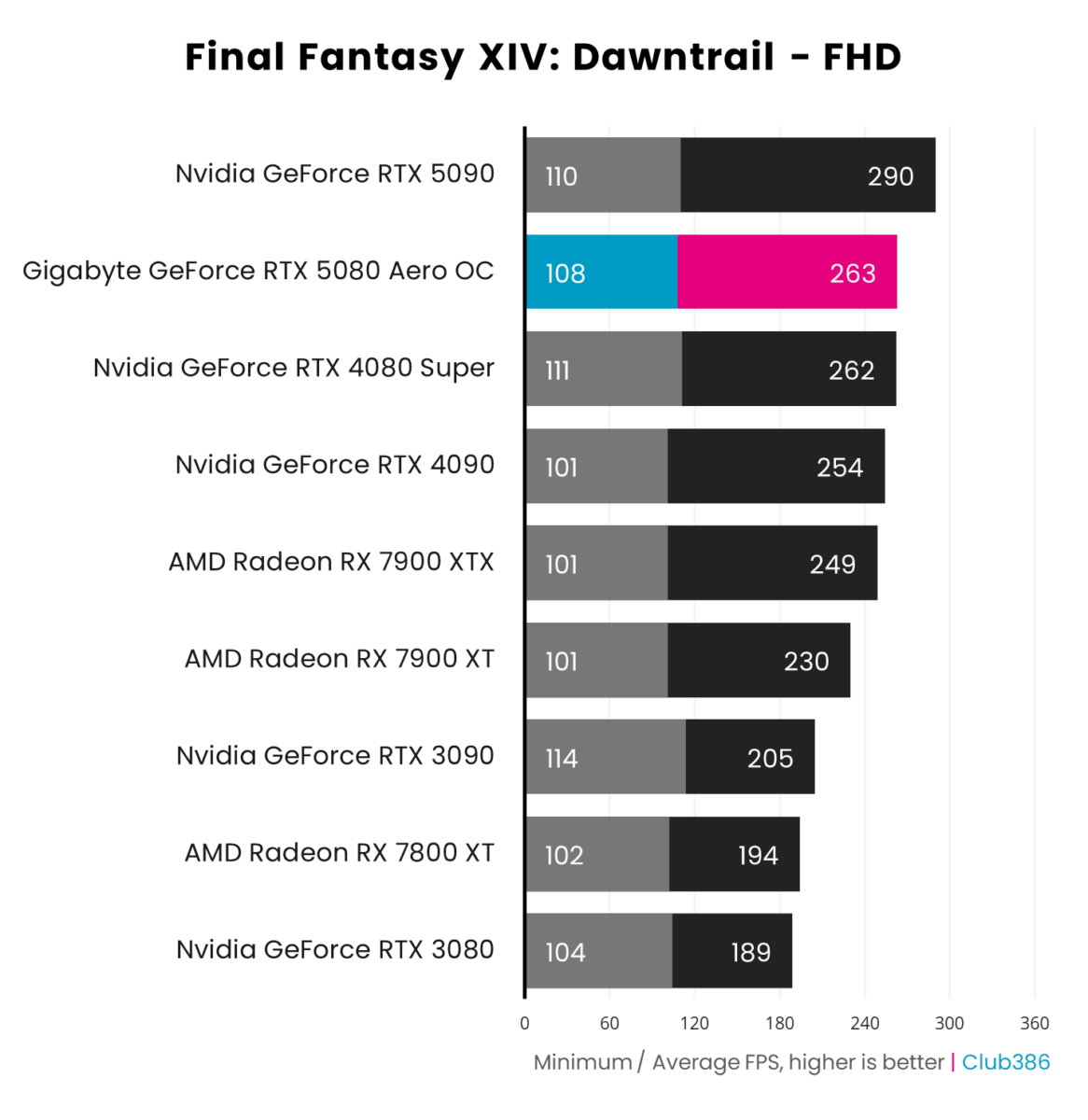
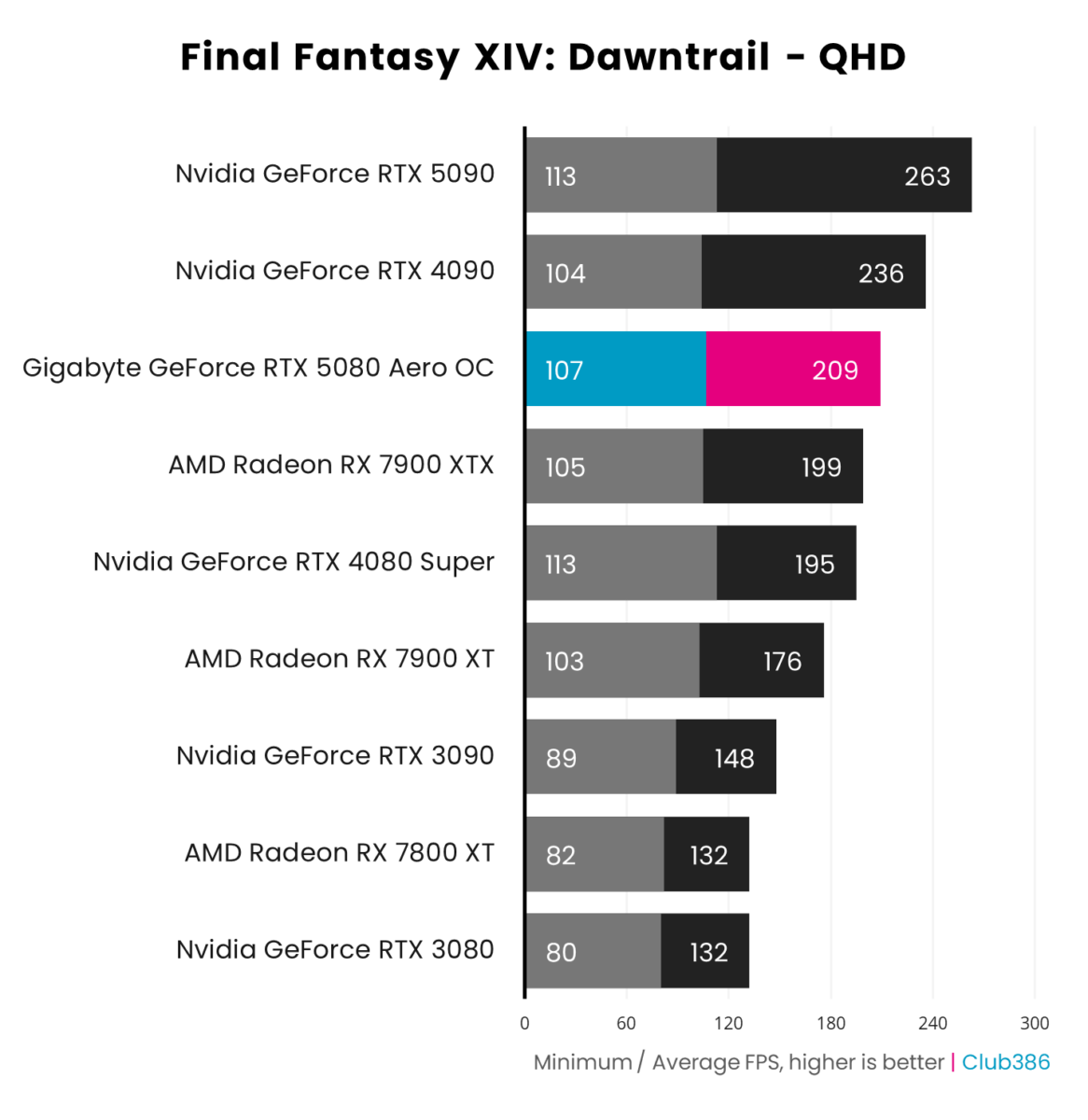
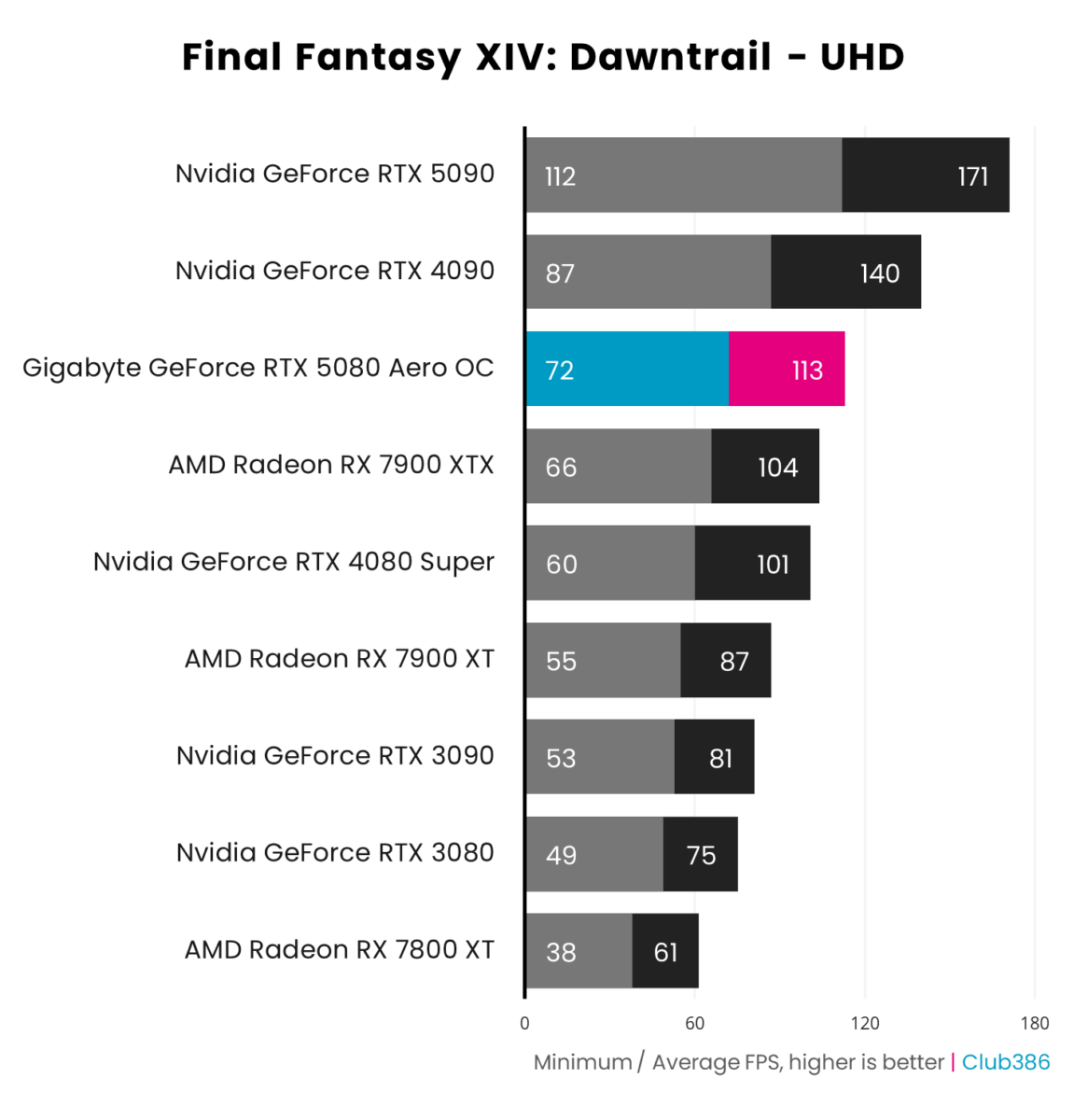
The lines between GeForce RTX 5080 and its closest 40 Series relations blur at FHD in Final Fantasy XIV: Dawntrail, as but 1fps separates it from RTX 4080 Super. However, as resolutions rise and pressure eases on the CPU conversely increasing on the GPU, the performance gaps between Aero OC SFF and its competitors become clearer.
Sat behind GeForce RTX 5090 and 4090 once again, the realm of Hydaelyn awards this RTX 5080 another bronze medal at QHD and UHD. Respectively pushing north of 200fps and 100fps at each resolution, this graphics card has the grunt to enjoy the MMORPG with pixels aplenty.
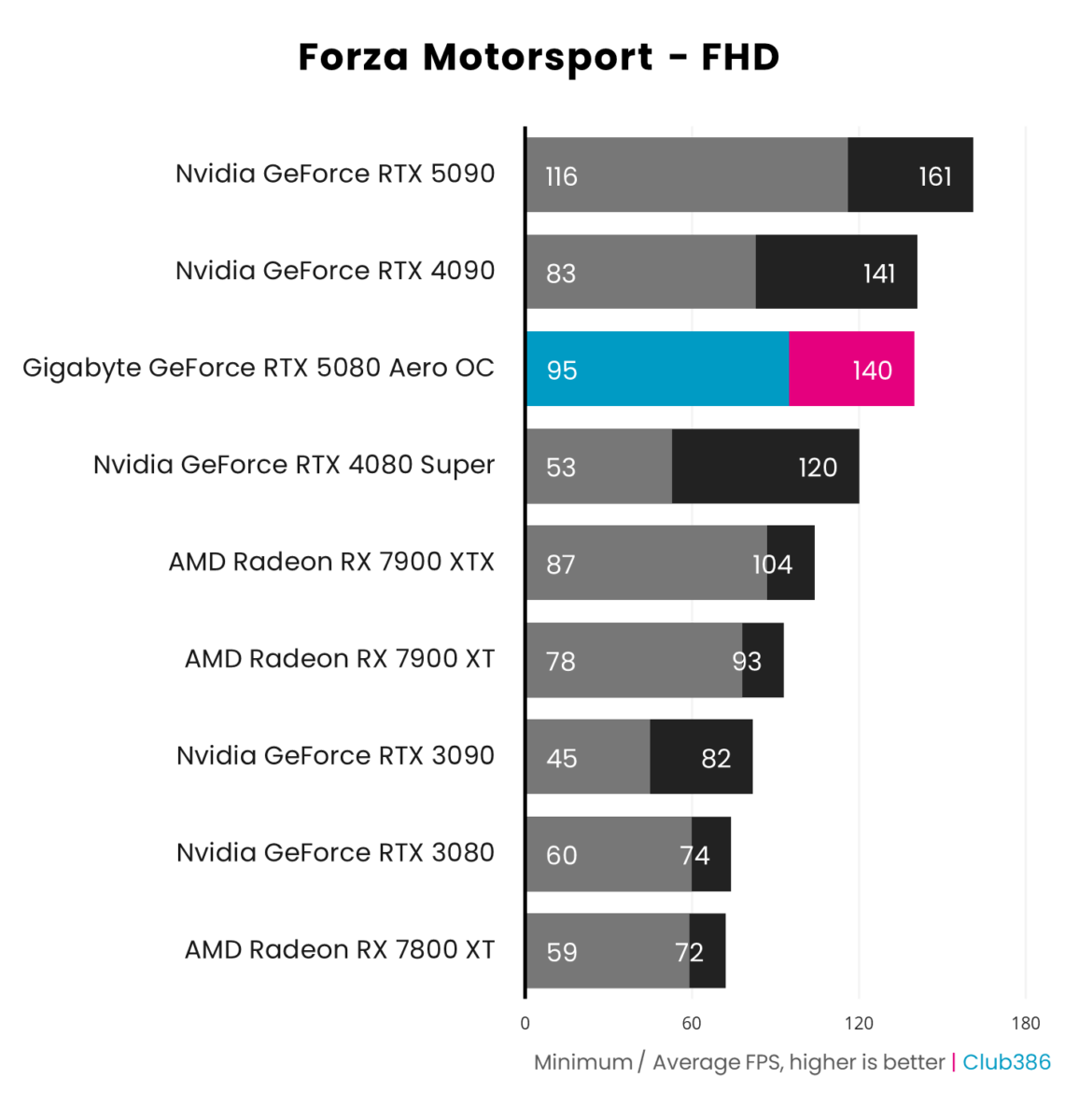
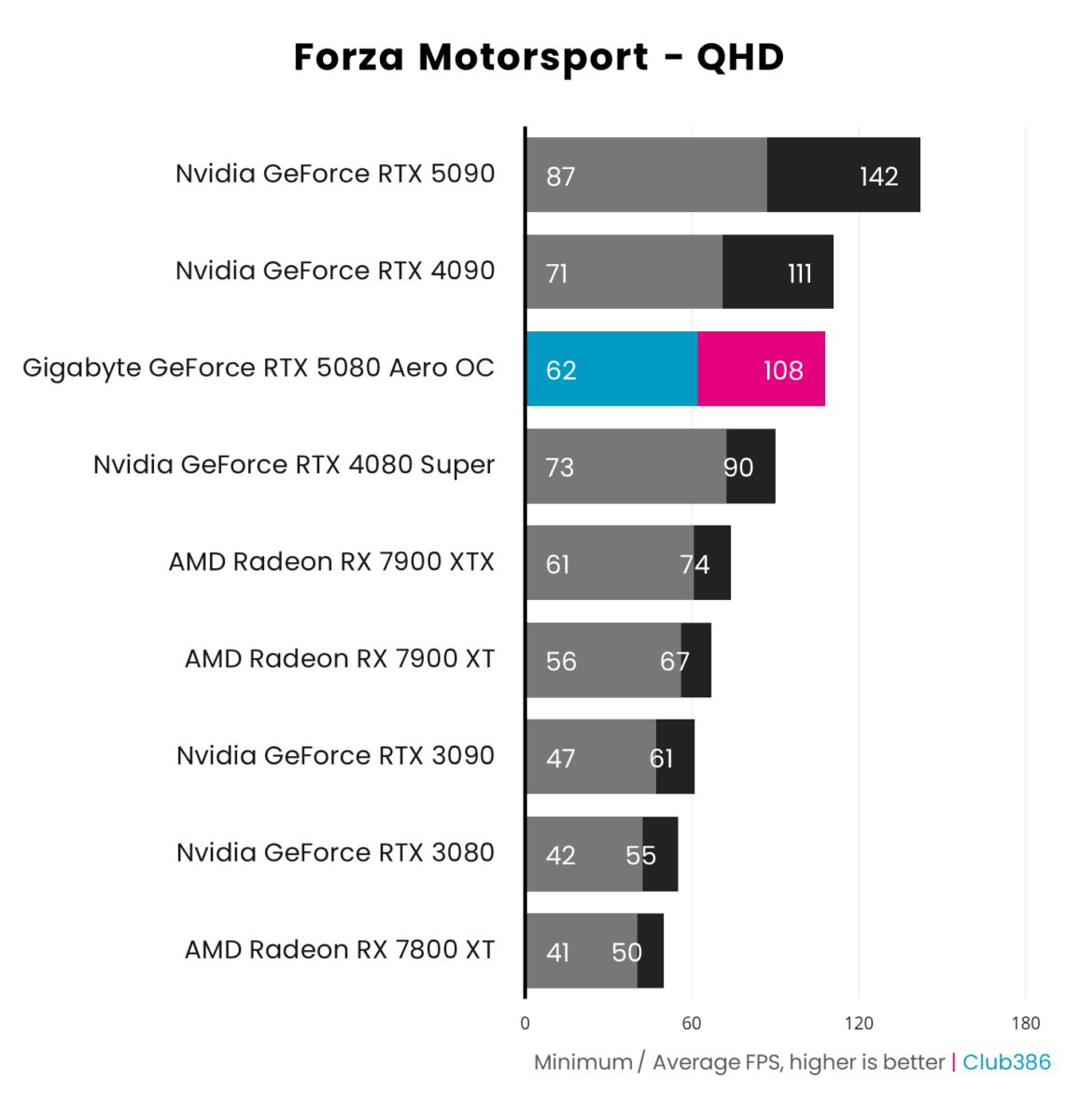
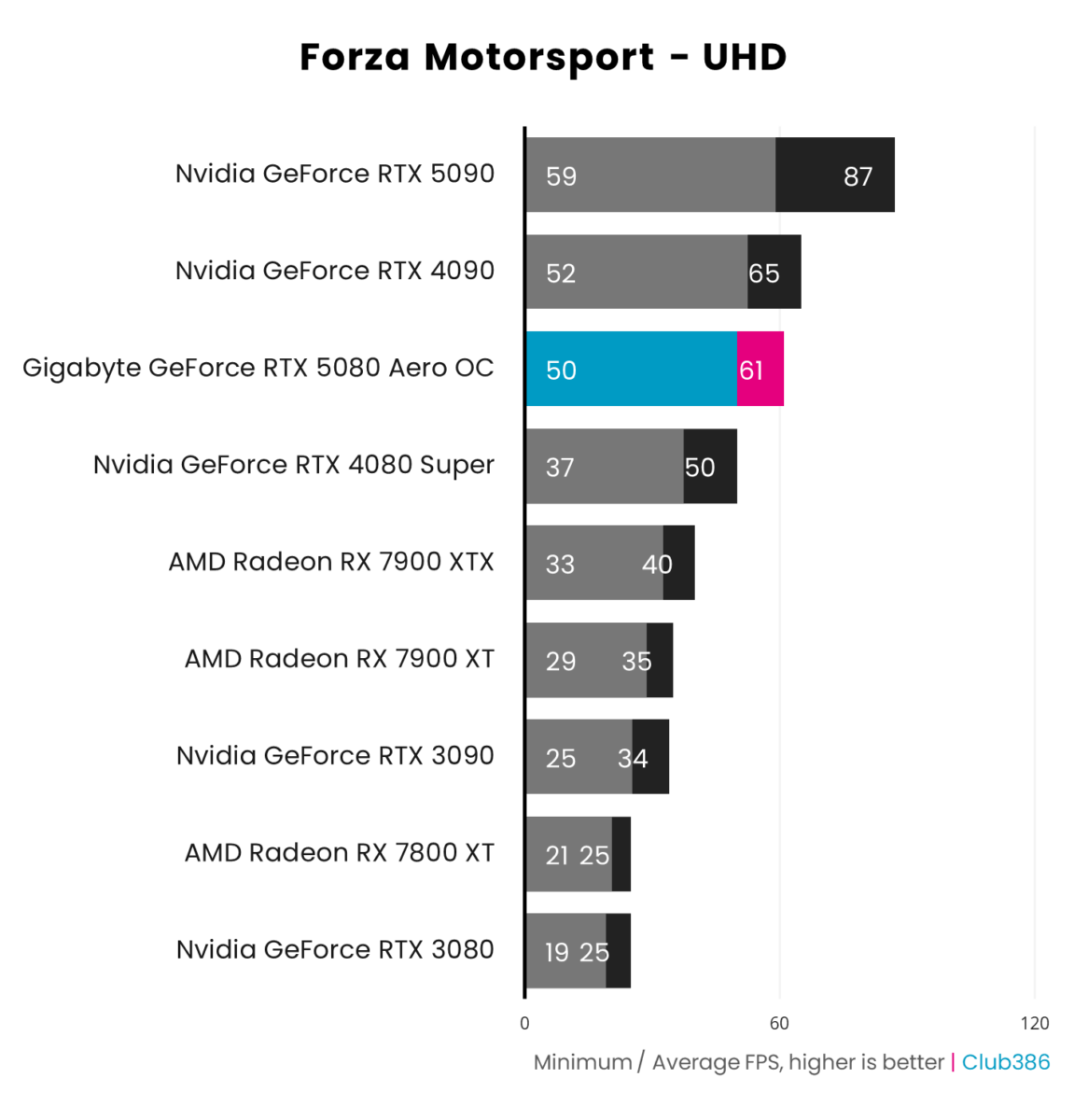
Up until now, GeForce RTX 4090 has maintained a comfortable distance between itself and RTX 5080. However, four frames at most now separate the two graphics cards as they race one another on the ray traced tarmac of Forza Motorsport.
Overlocks come in clutch (pun intended) for Aero OC SFF as it pushes UHD frame rates above that all-important 60fps par. This level of performance puts it in the hallowed company of GeForce RTX 4090 and 5090, as they’re the only other graphics cards to achieve the same feat.
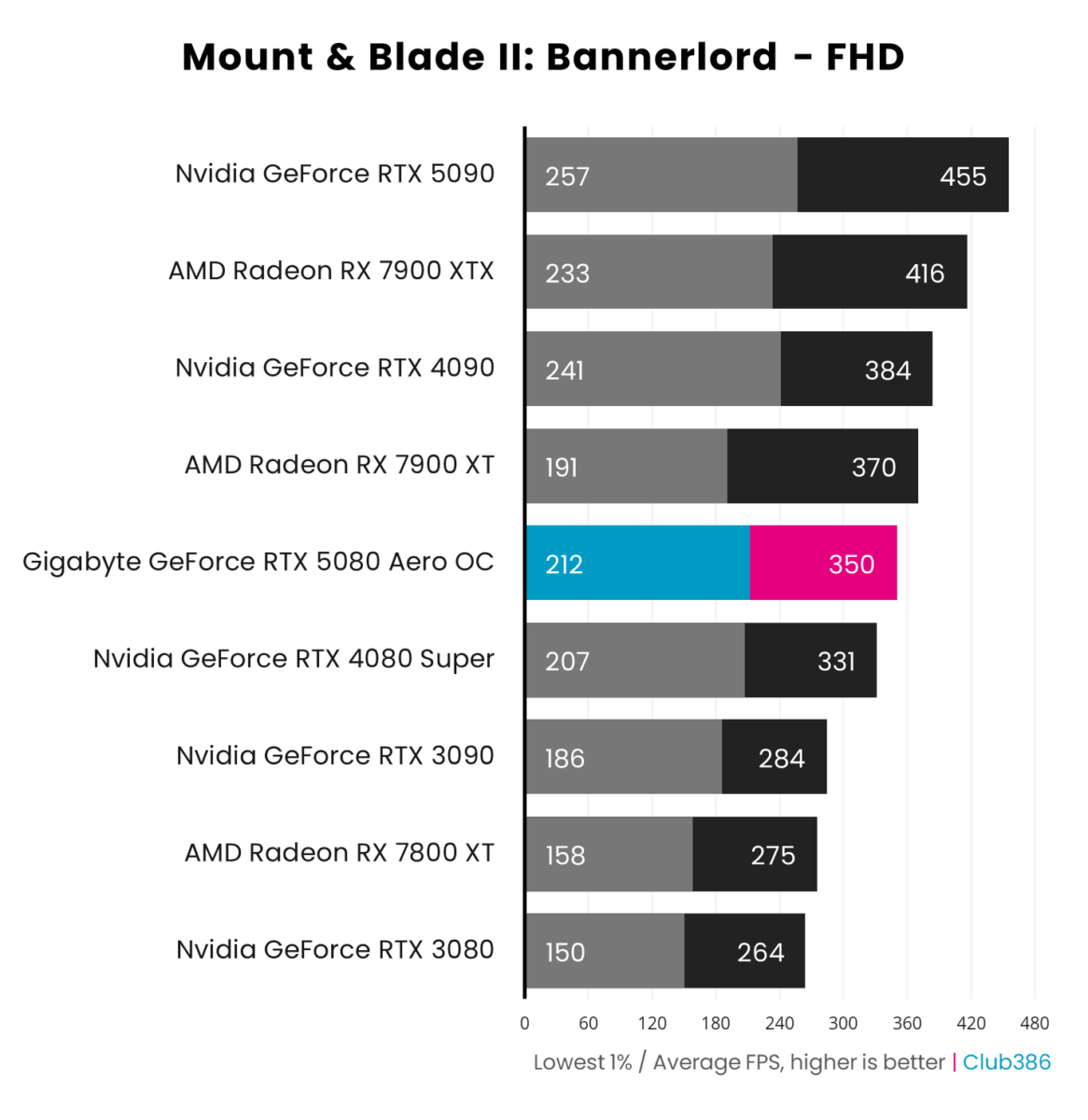
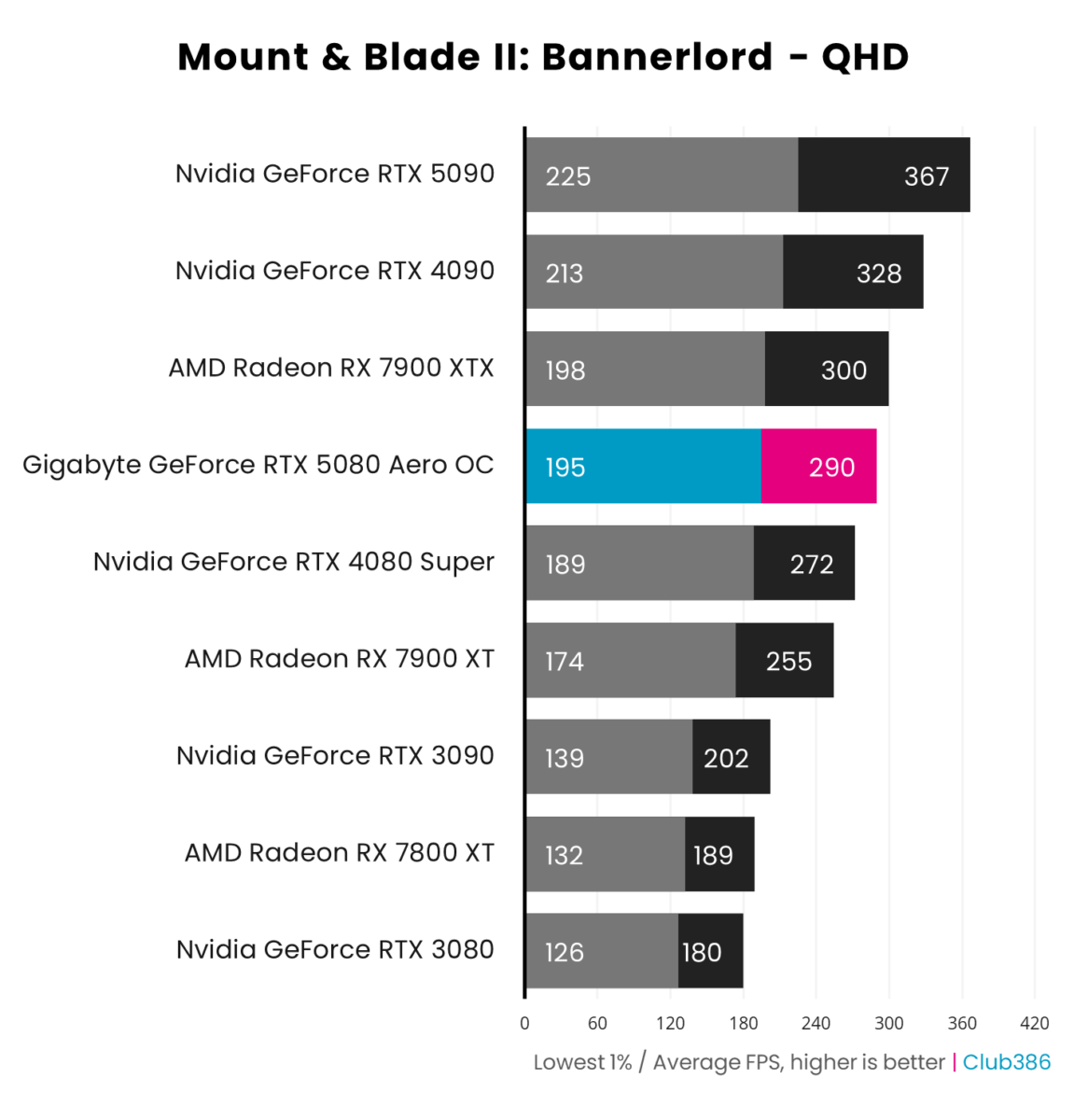
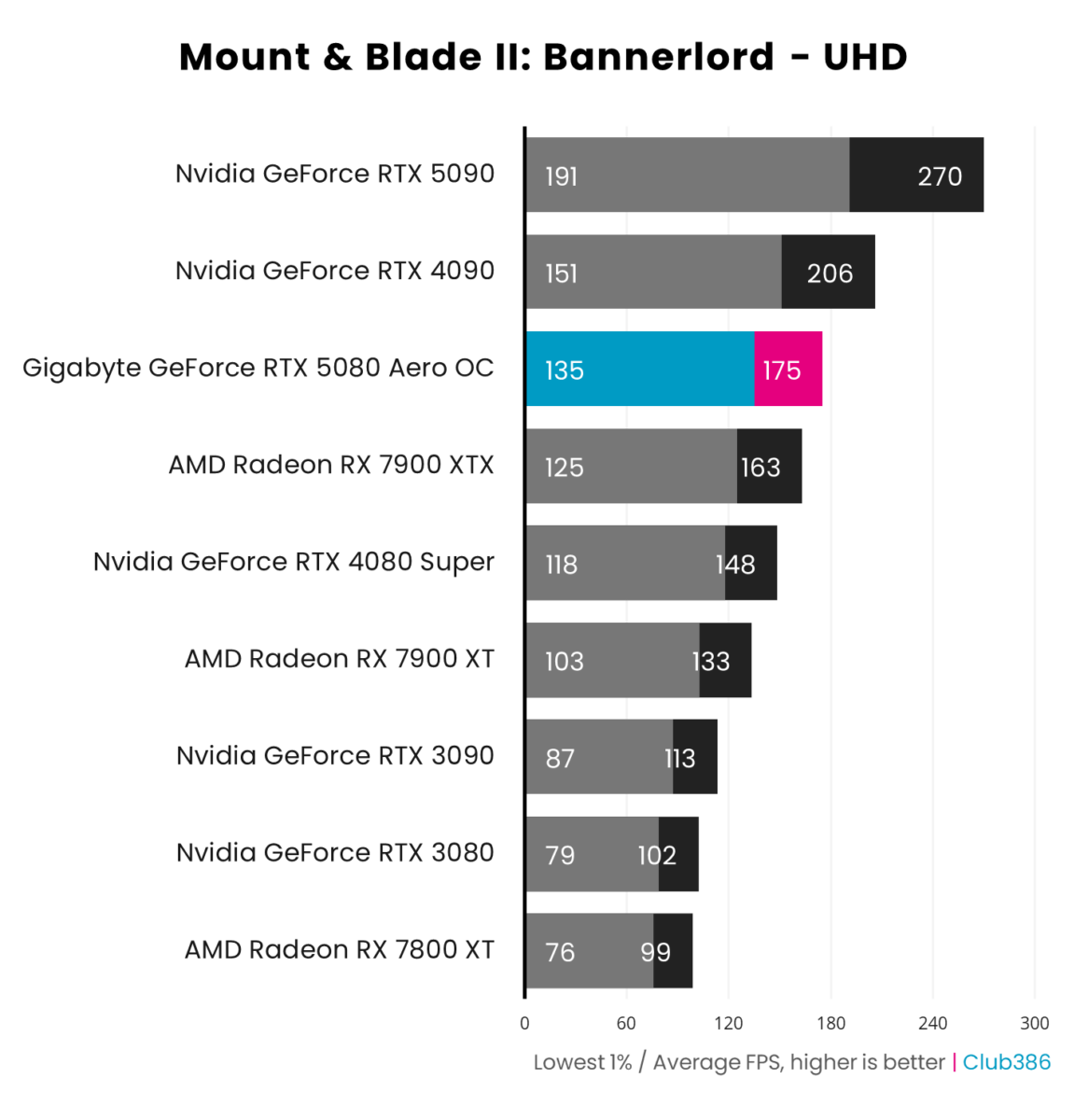
The battle for GPU supremacy turns surprisingly bloody in Mount & Blade II: Bannerlord, as Radeon RX 7900 XTX musters a second-place position and RX 7900 XT pushes GeForce RTX 5080 down to fifth place at FHD. However, the war favours the Blackwell pixel pusher as the intensity of resolution increases, rising to fourth at QHD and third at UHD.
More interesting, though, are the generational gains in rasterised rendering between GeForce RTX 5080 and 4080 Super. At FHD it’s a mere 6%, rising to 7% at QHD, before rapidly climbing to 18% at UHD. More memory bandwidth evidently paying dividends.
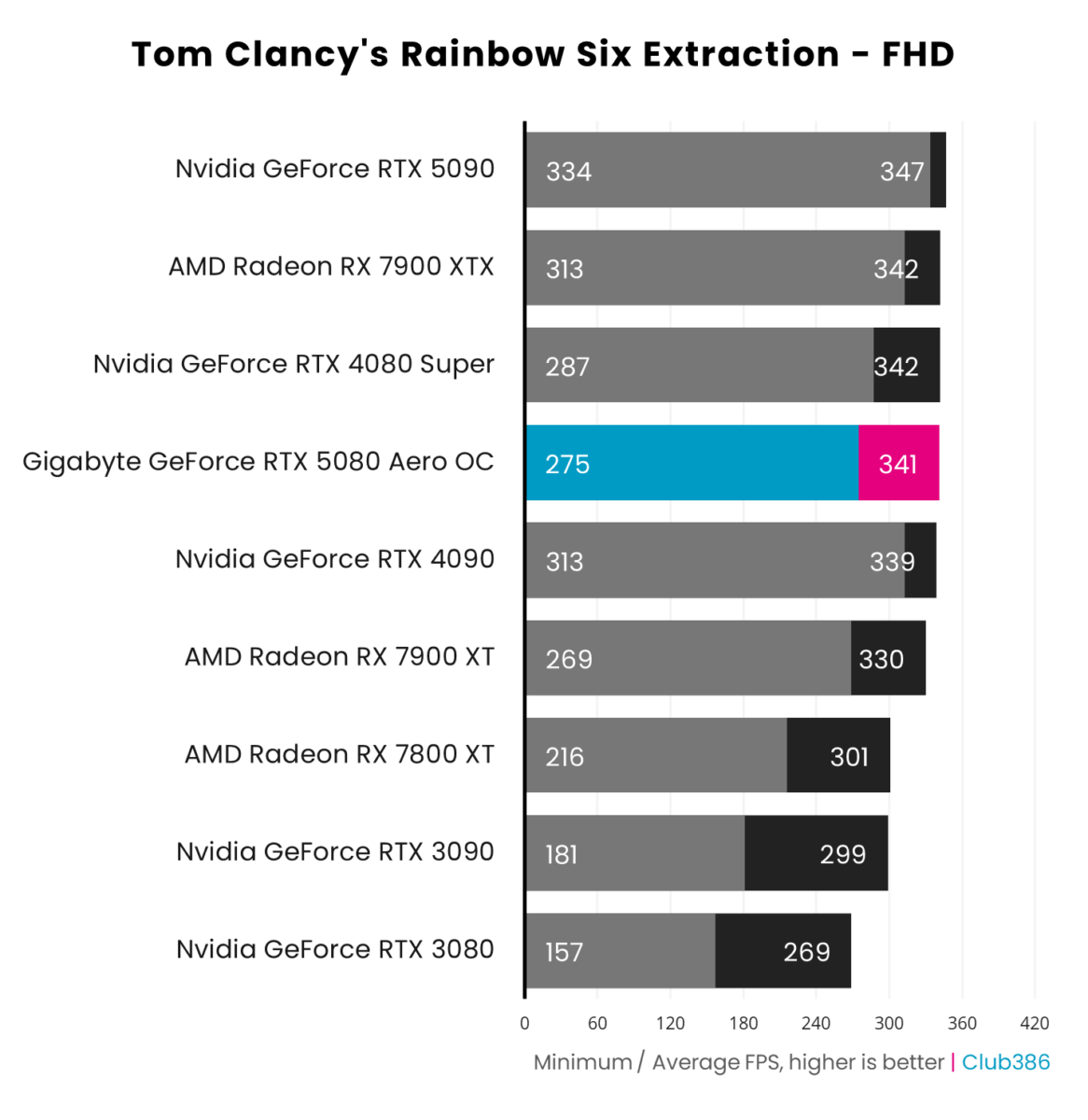
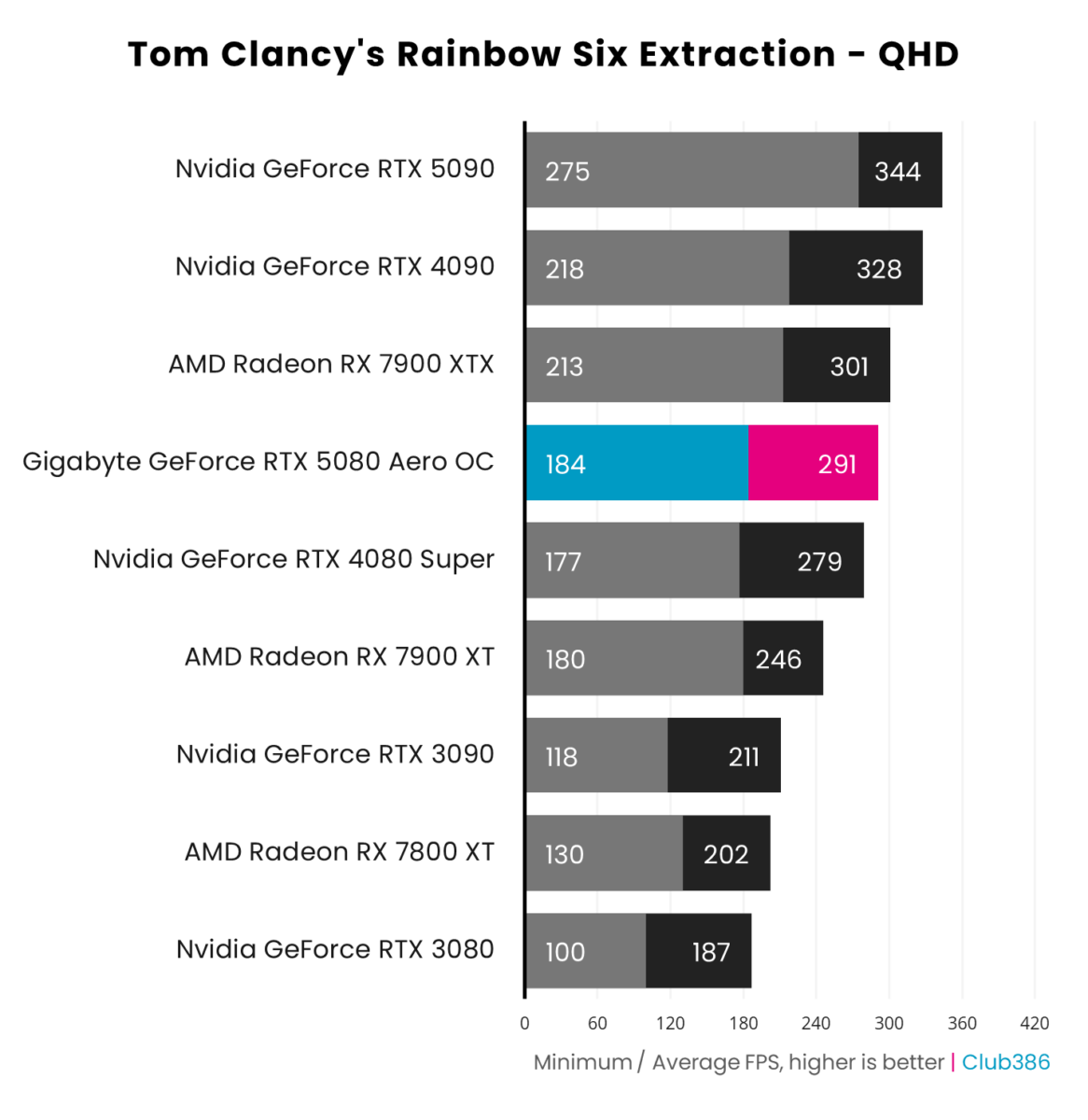
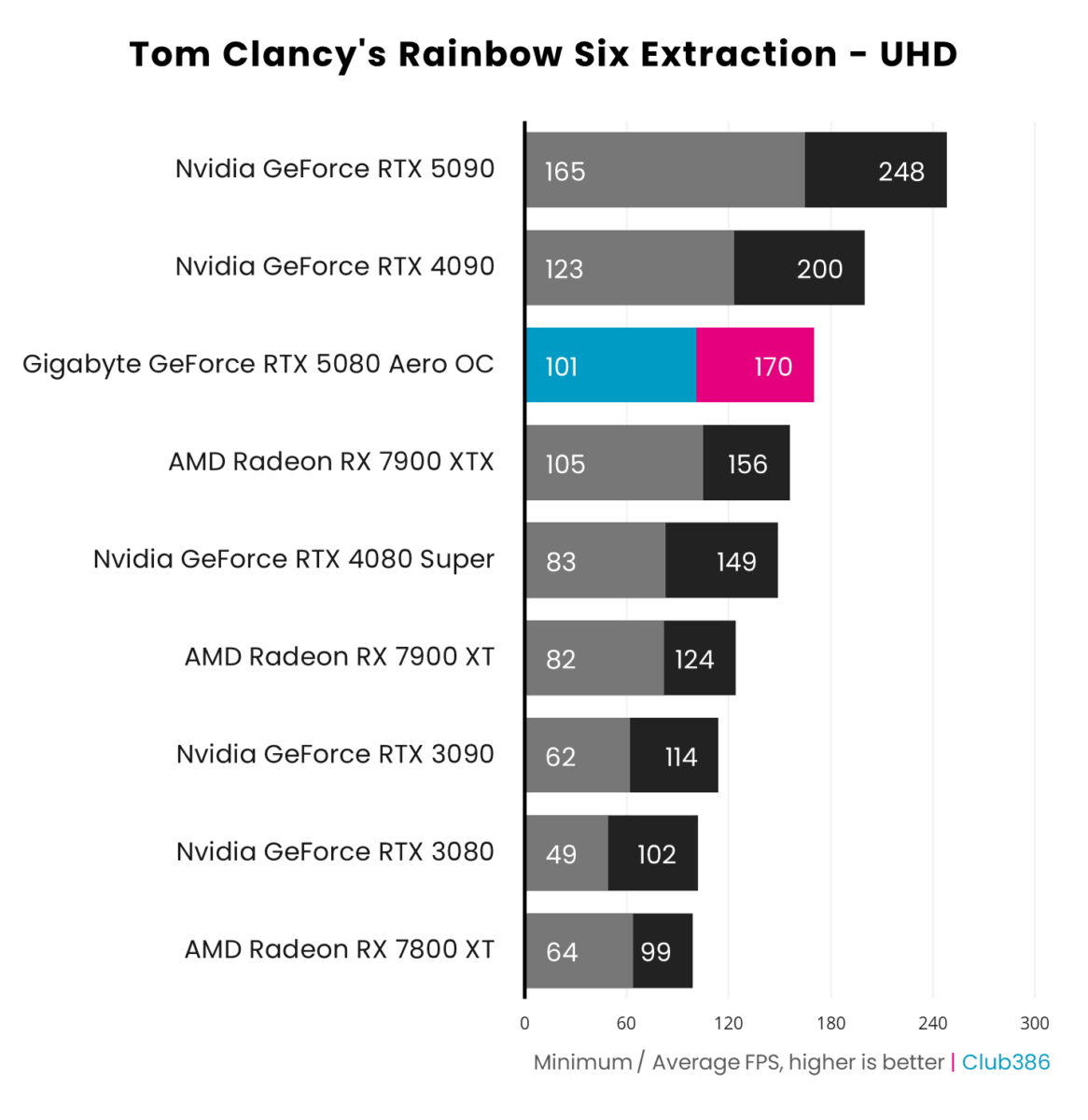
Rainbow Six Extraction serves as a great equaliser of average frame rates for the fastest graphics cards of today, including GeForce RTX 5080. At FHD, differences in average frame rates are difficult to discern or non-existent but gaps grow at QHD and UHD.
An advantage waiting in the wings for GeForce RTX 5080 is Nvidia Reflex 2 which promises to further improve responsiveness in games. Its core innovation is ‘Frame Warp’ which will see the graphics card update frames with the latest mouse inputs before sending them to your display. This should allow you to more consistently and easily land game-winning shots but the feature is unproven for now.
DLSS
GeForce RTX 5080 has already established itself as a graphics card capable of impressive frame rates, particularly with Aero OC SFF’s overclocks in tow in some scenarios. Such a strong foundation bears fruit when it comes to frame generation, too, both single and multi.
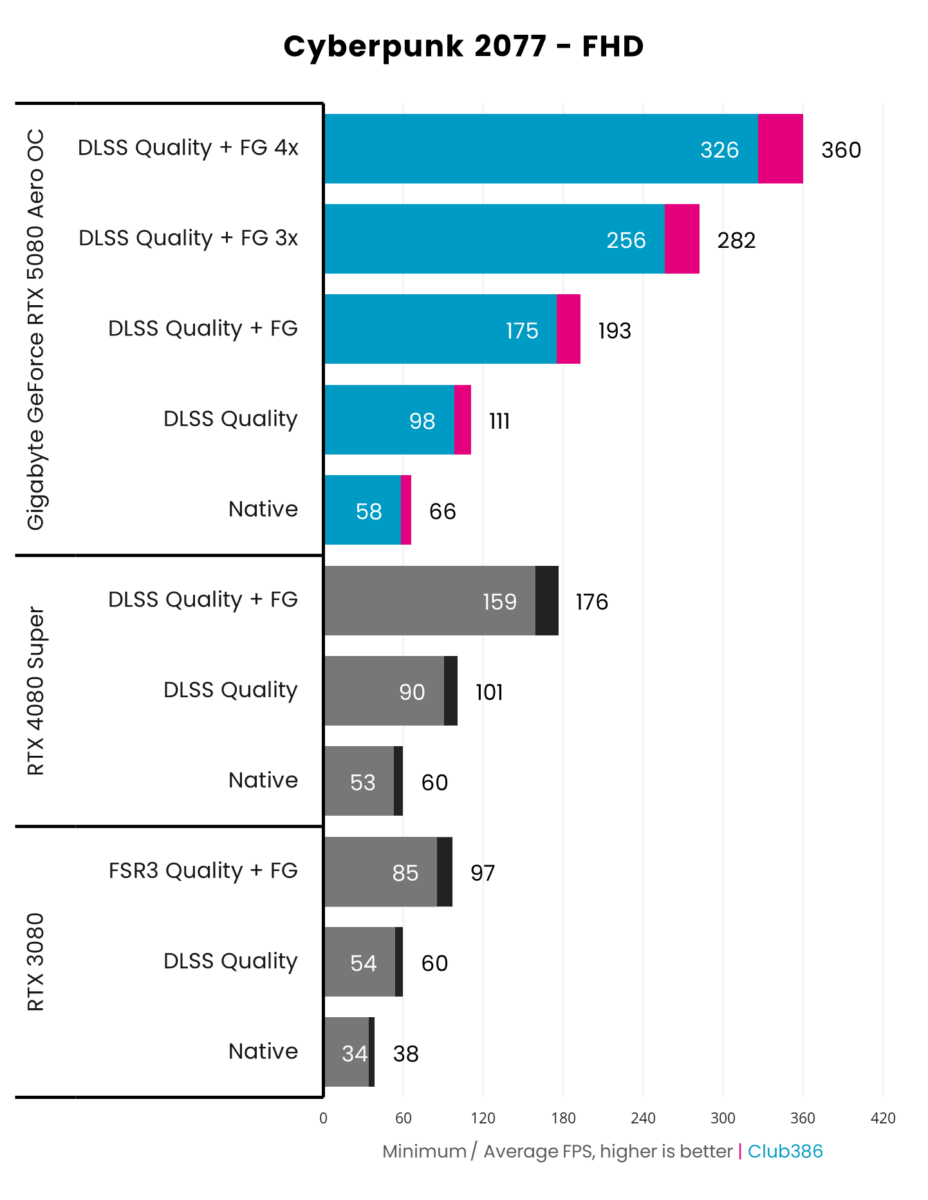
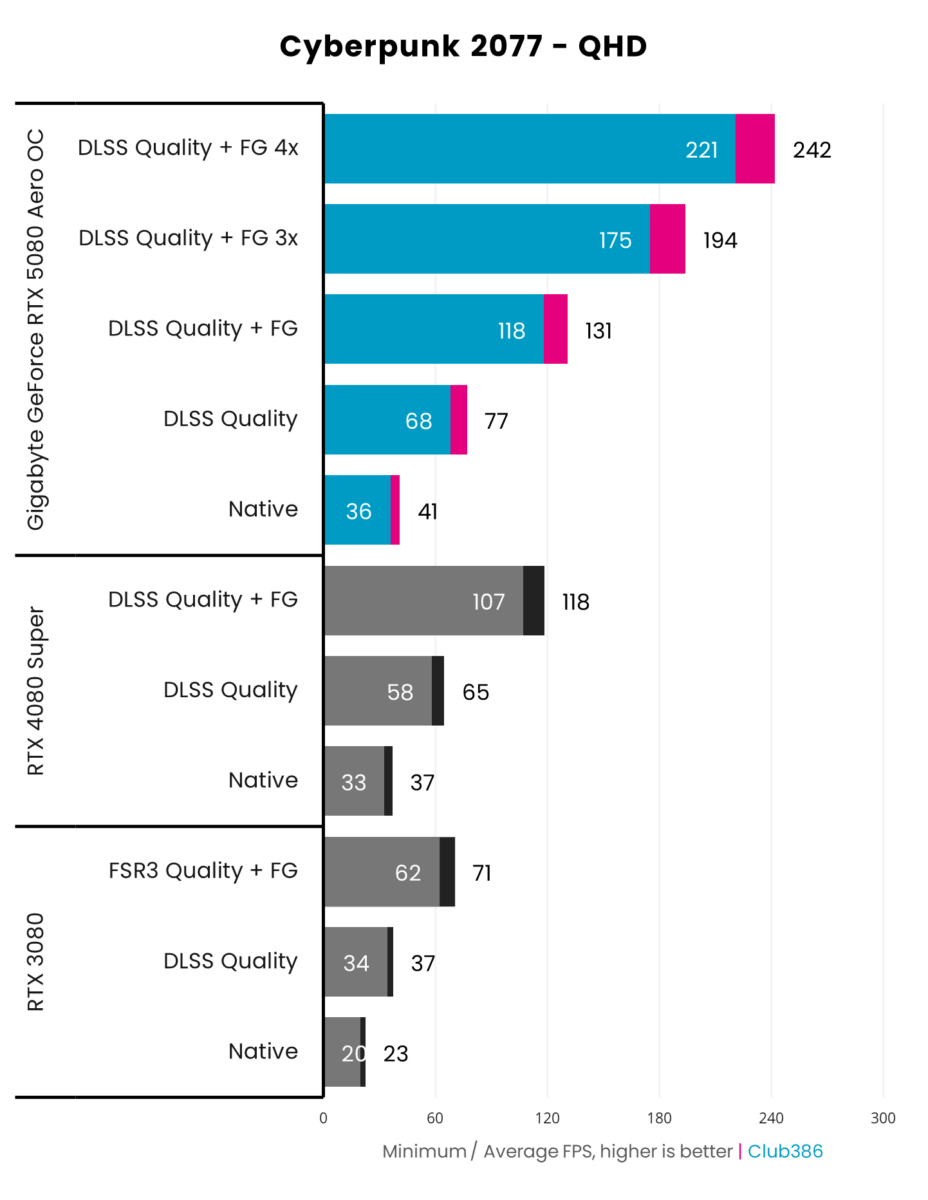
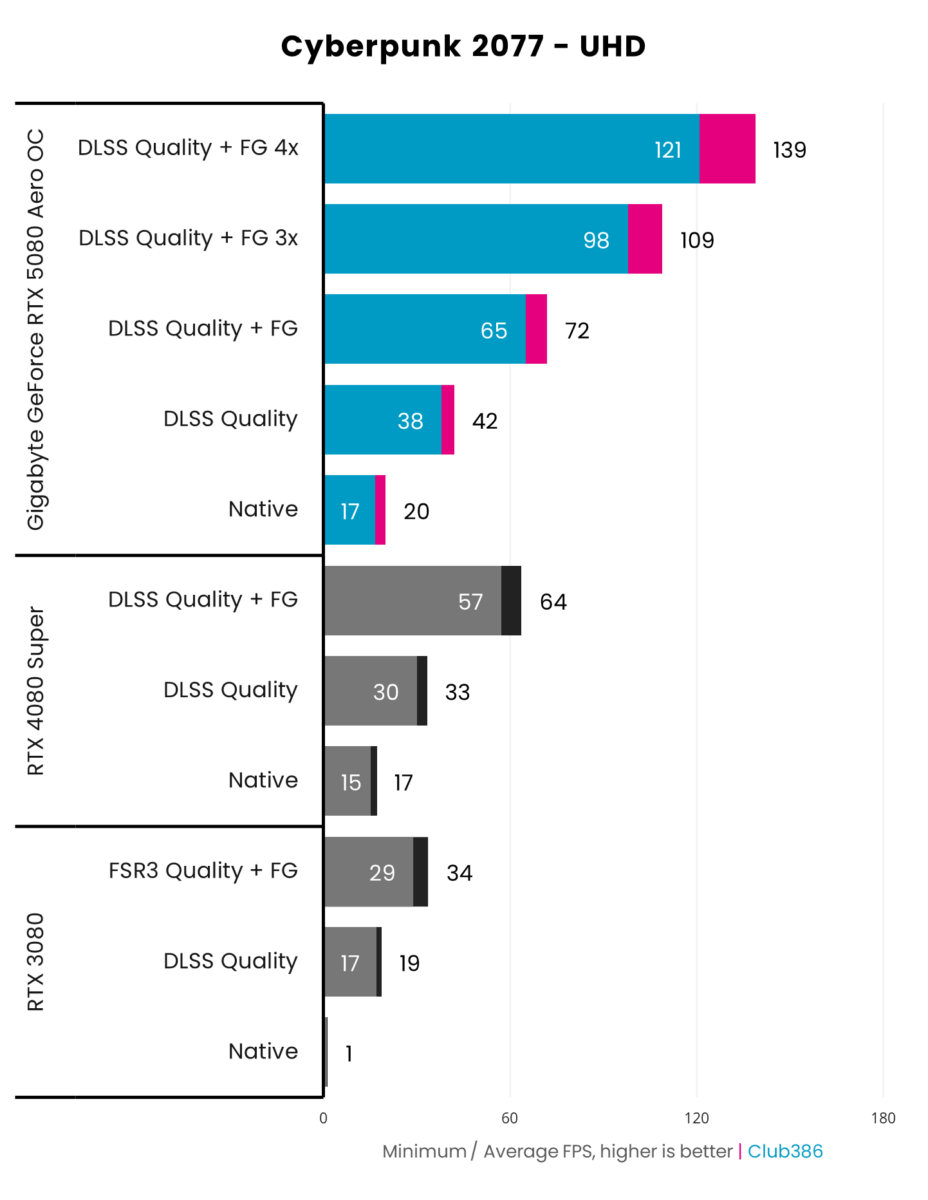
Comparing GeForce RTX 5080 against its predecessors, the generational leaps in ray tracing are plain to see. Even without upscaling, the card manages to fire off 66fps in Cyberpunk 2077 at native FHD using the game’s path traced RT Overdrive preset, a 10% uplift relative to RTX 4080 Super.
Introduce DLSS upscaling into the mix, though, and frame rates increase exponentially into triple digits at FHD. Meanwhile, performance punches north of 60fps at QHD and reaches acceptable levels at UHD beyond 30fps. The visual quality of ray traced effects also increases as an added bonus thanks to Nvidia Ray Reconstruction, providing higher quality denoising.
Frame generation generally requires a base frame rate of 60fps to keep input latency in check, which is fine at FHD for GeForce RTX 5080 but is less so at QHD and UHD. Thankfully, adopting a lower base resolution by dropping DLSS from ‘Quality’ to ‘Balanced’ or ‘Performance’ should provide the necessary headroom at the two higher resolutions.
Once you meet these requirements though, the visual fluidity of Multi Frame Generation is impressive to behold. While this feature can’t replicate the feel of a native 240fps output, as RTX 5080 pushes 242fps while using it at FHD, Night City does look noticeably smoother to the eye. It’s pleasing to the point that it’s difficult to let go of once you experience it, particularly given the high quality of the generated frames in motion.
Conclusion
Gigabyte crafts an attractive package in terms of aesthetics and performance with GeForce RTX 5080 Aero OC SFF. In fact, I’d go so far as to say it’s among my favourite partner designs in large thanks to its conservative dimensions and minimalist stylings.
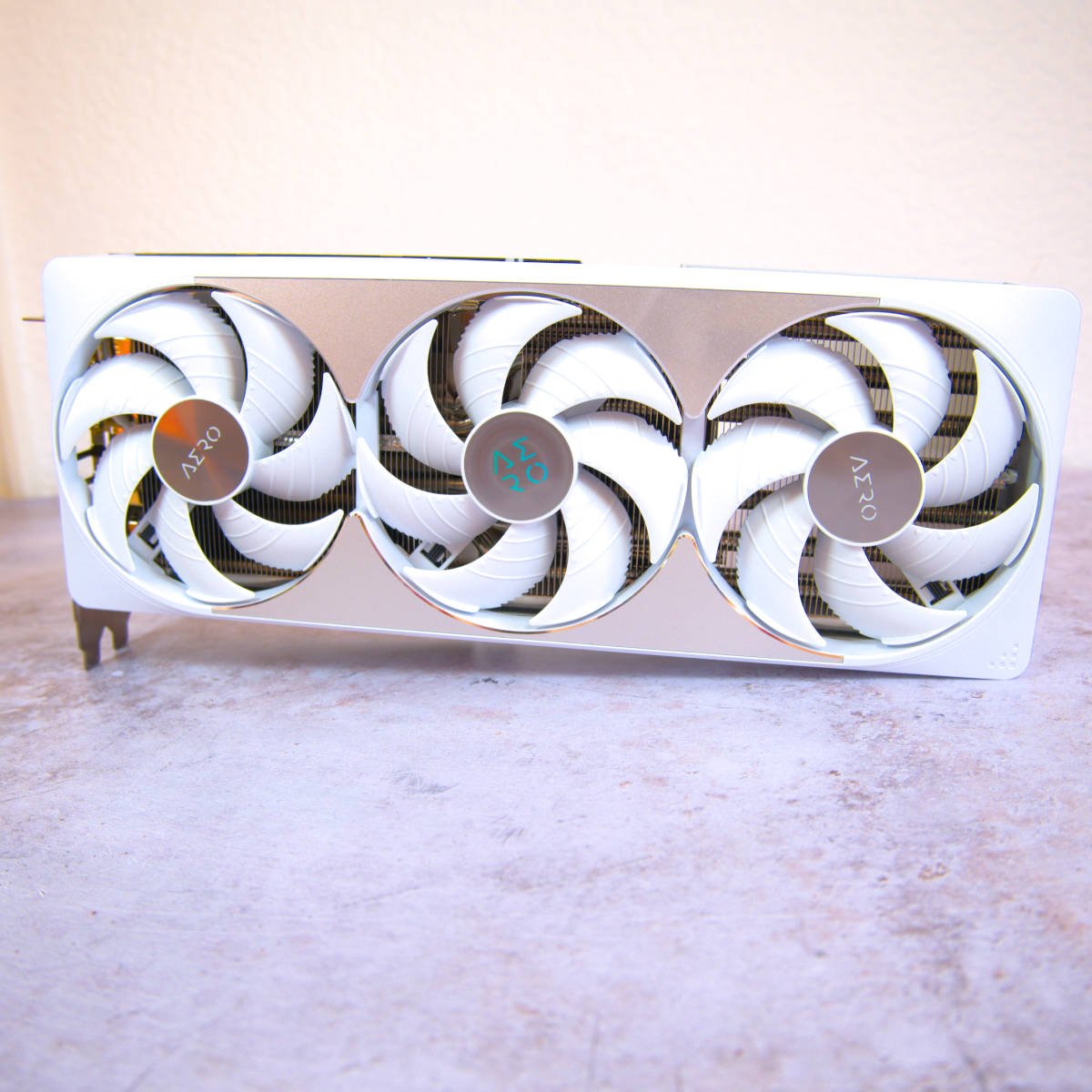
Warm as I am towards the card, its price leaves me cold. While Aero OC SFF is far from the only GeForce RTX 5080 to cost far more than Nvidia’s base RRP / MSRP, the growing gap between base price and actual retail availability is cause for concern. This is a good graphics card but in lieu of fanciful features like water cooling or a massive overclock it’s hard to justify a sizeable premium.
Too rich for my blood, yet this is the going rate for a white GeForce RTX 5080, and if you have your heart set on a themed build, Gigabyte’s card ticks practically every box other than price.

